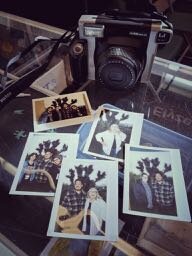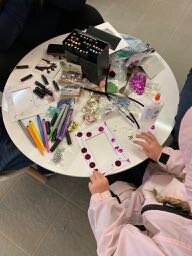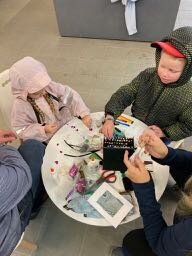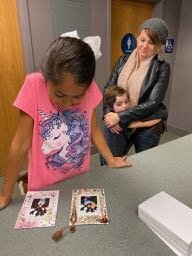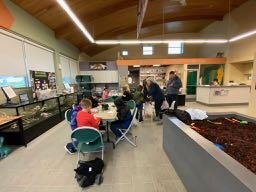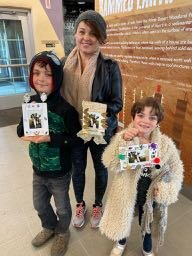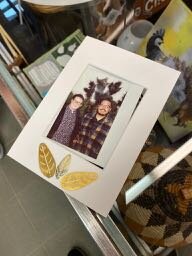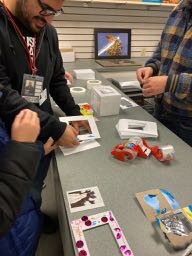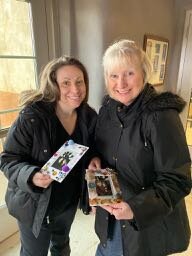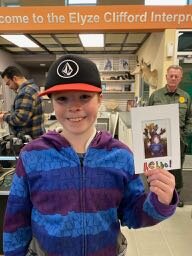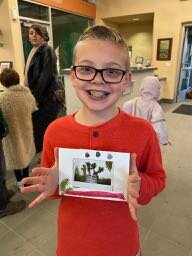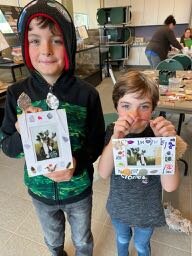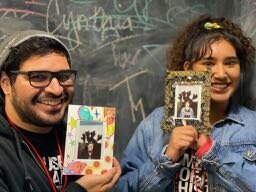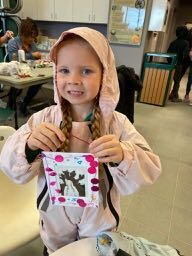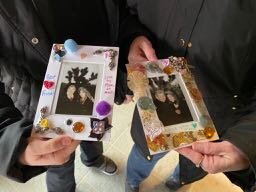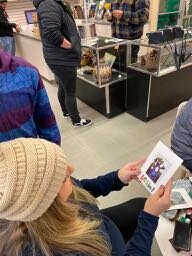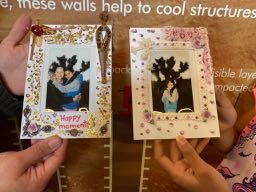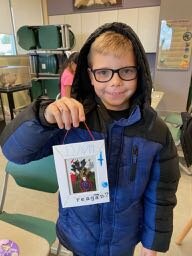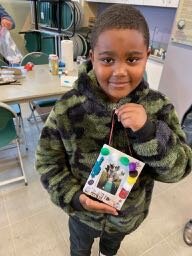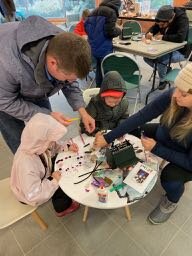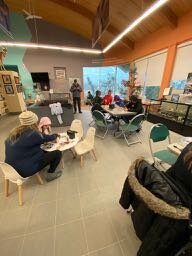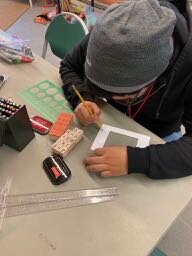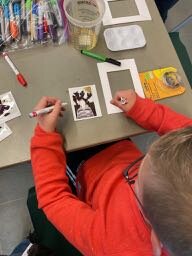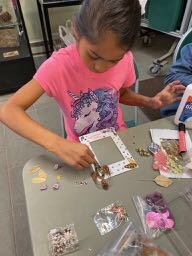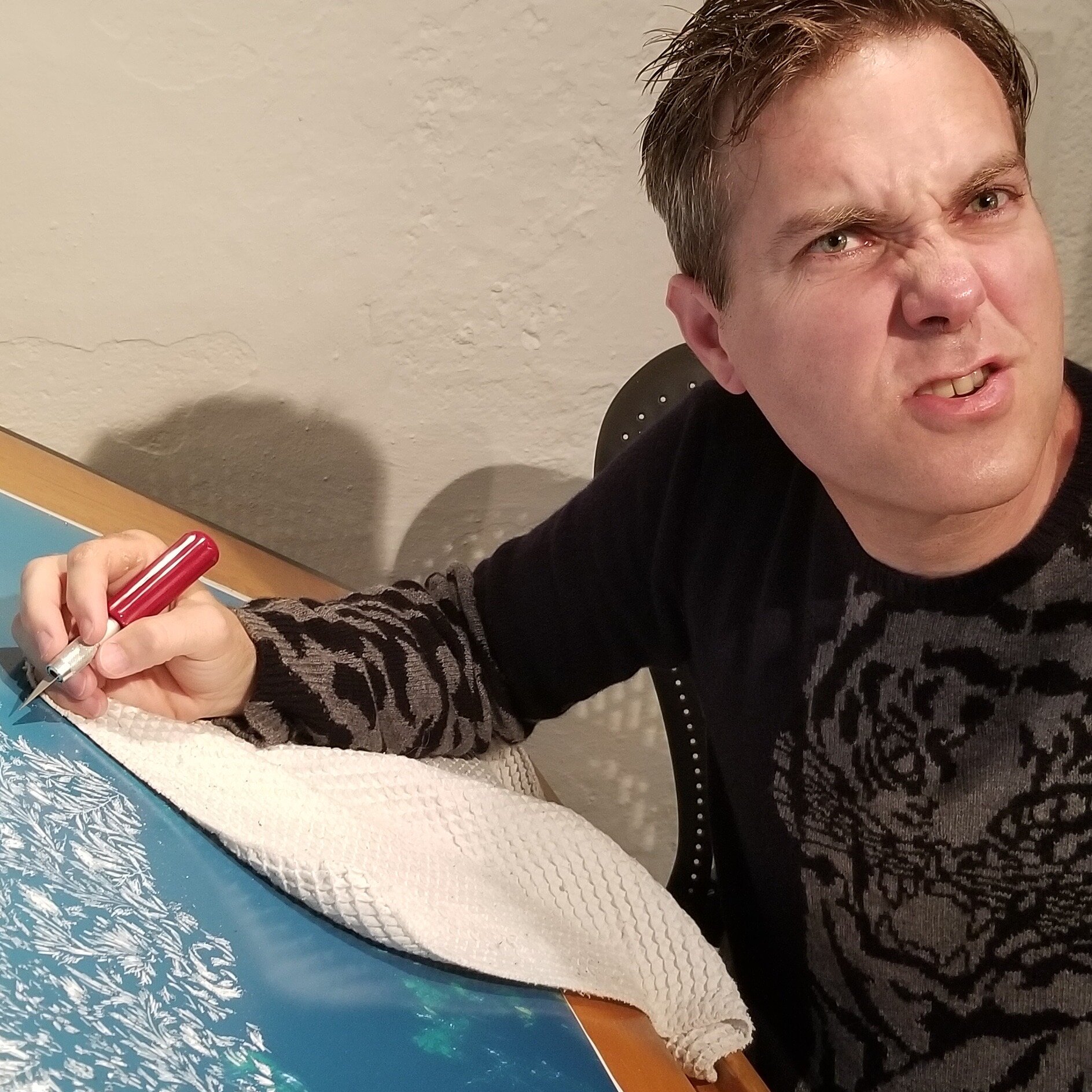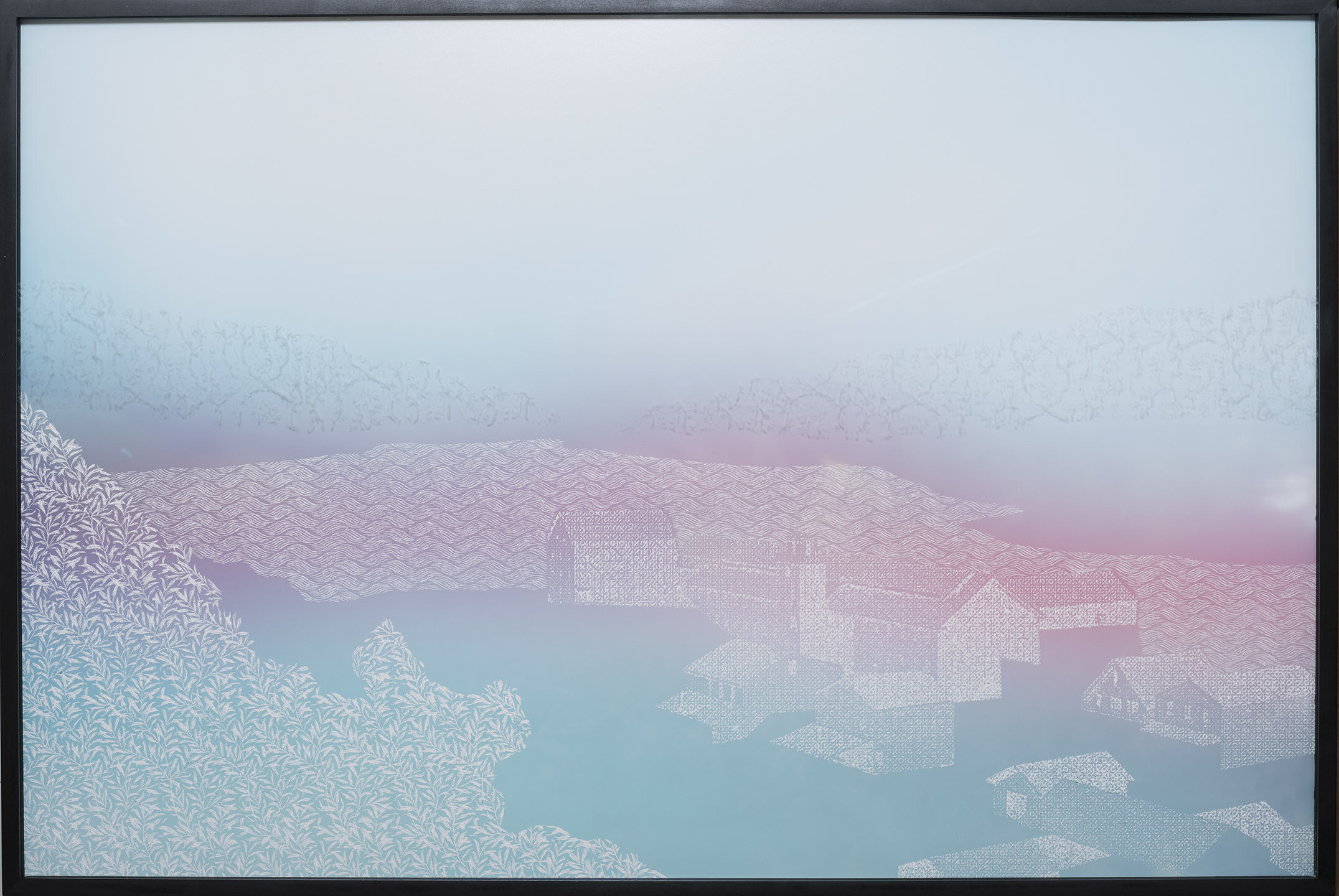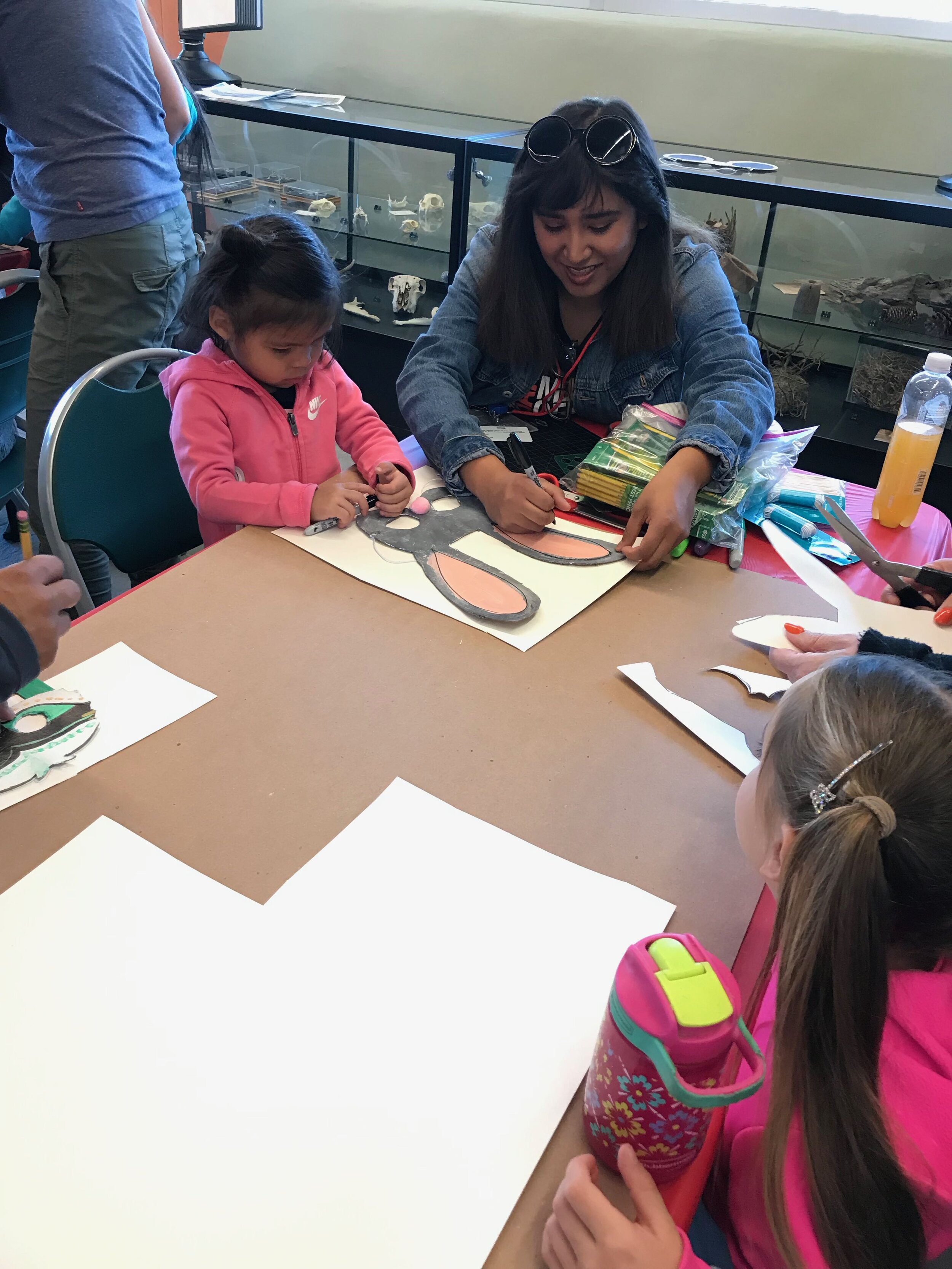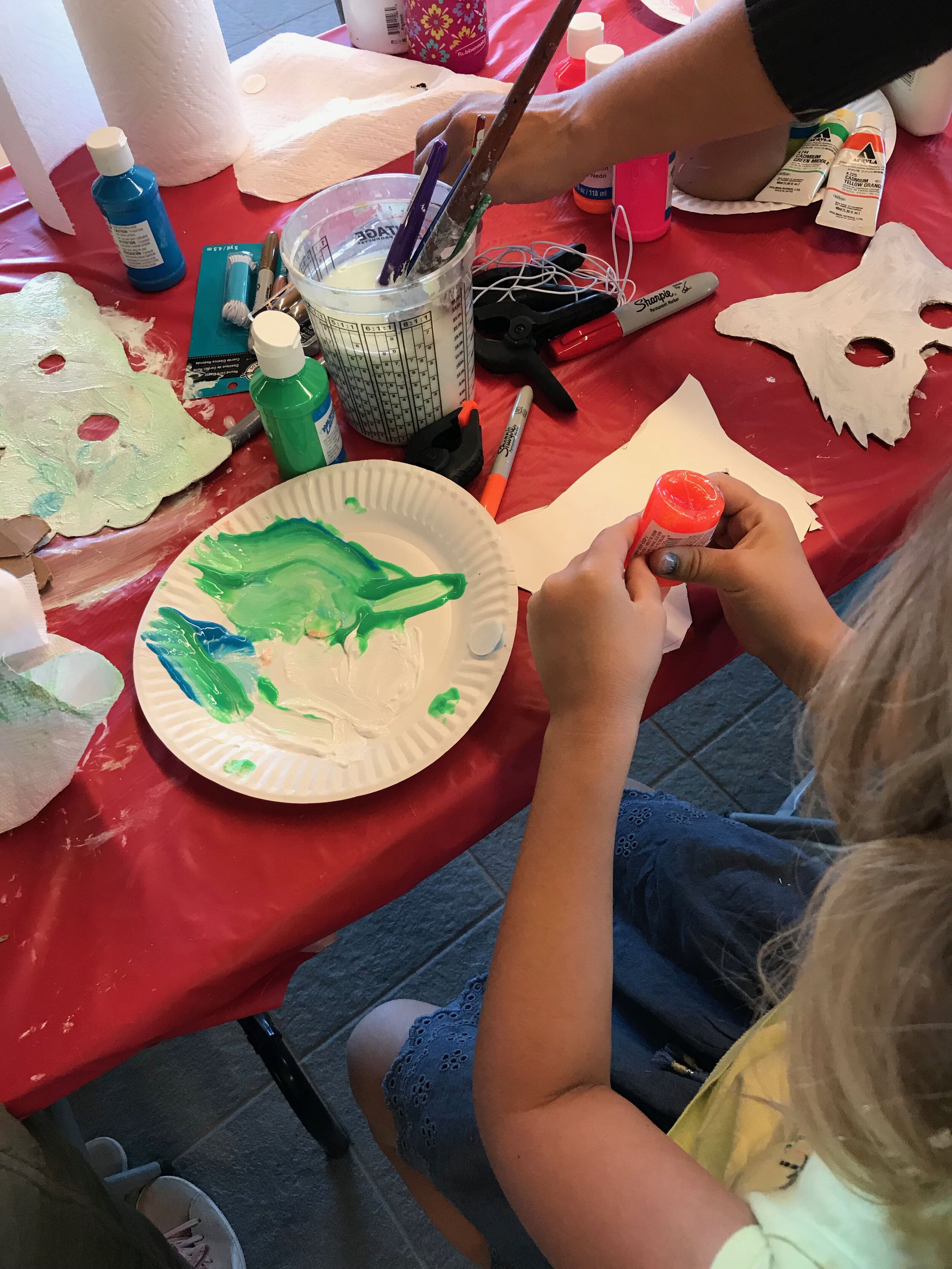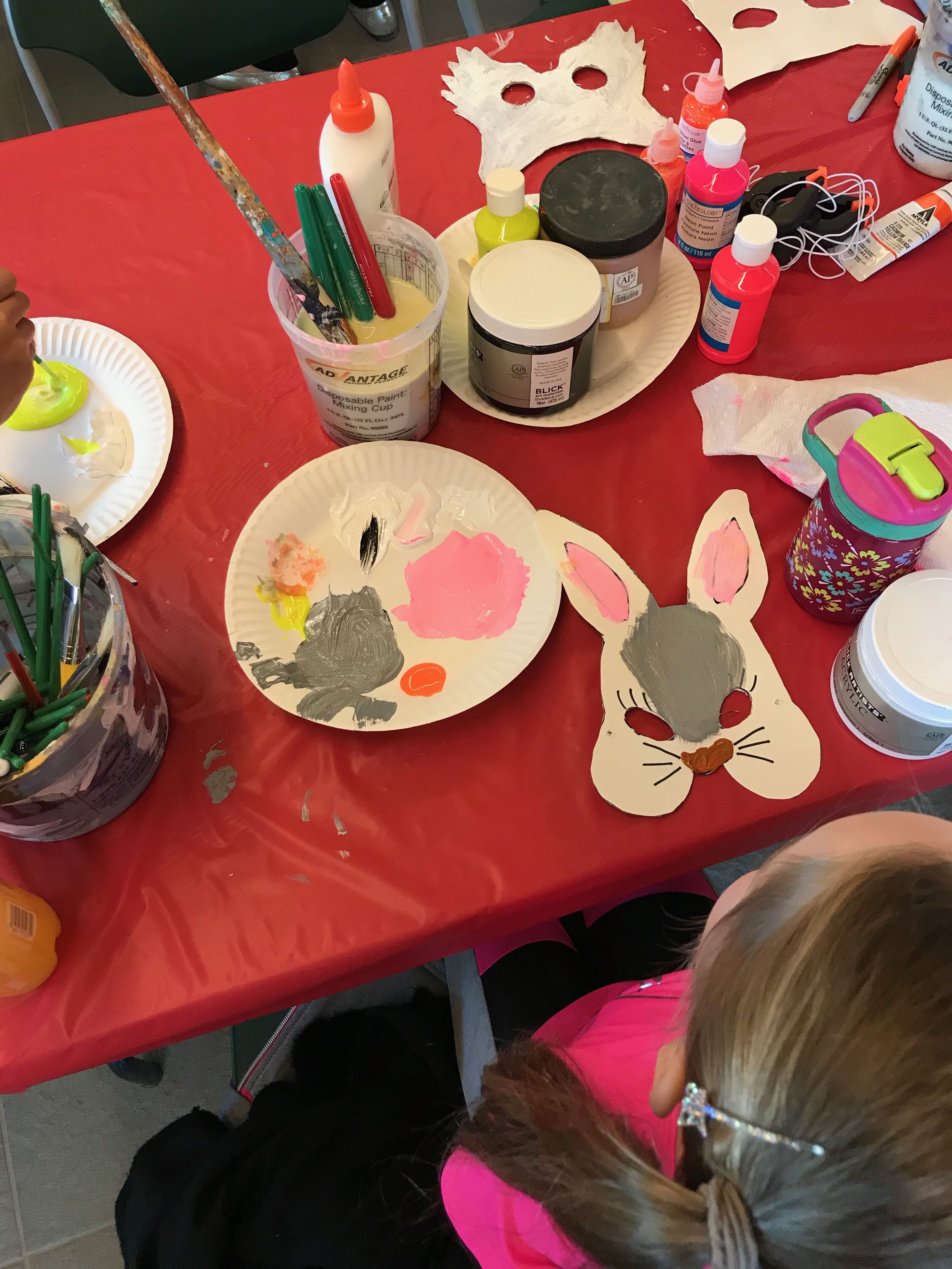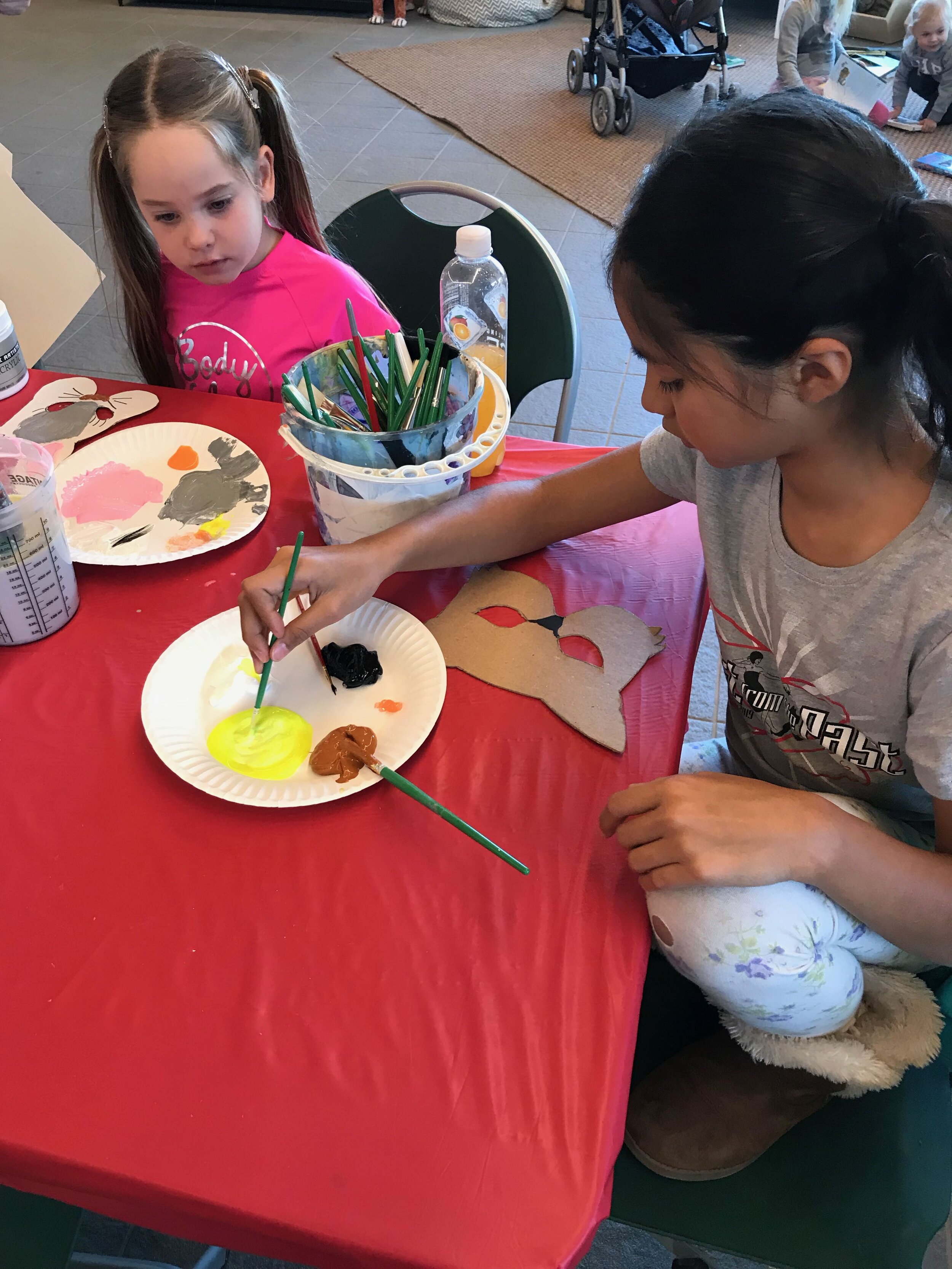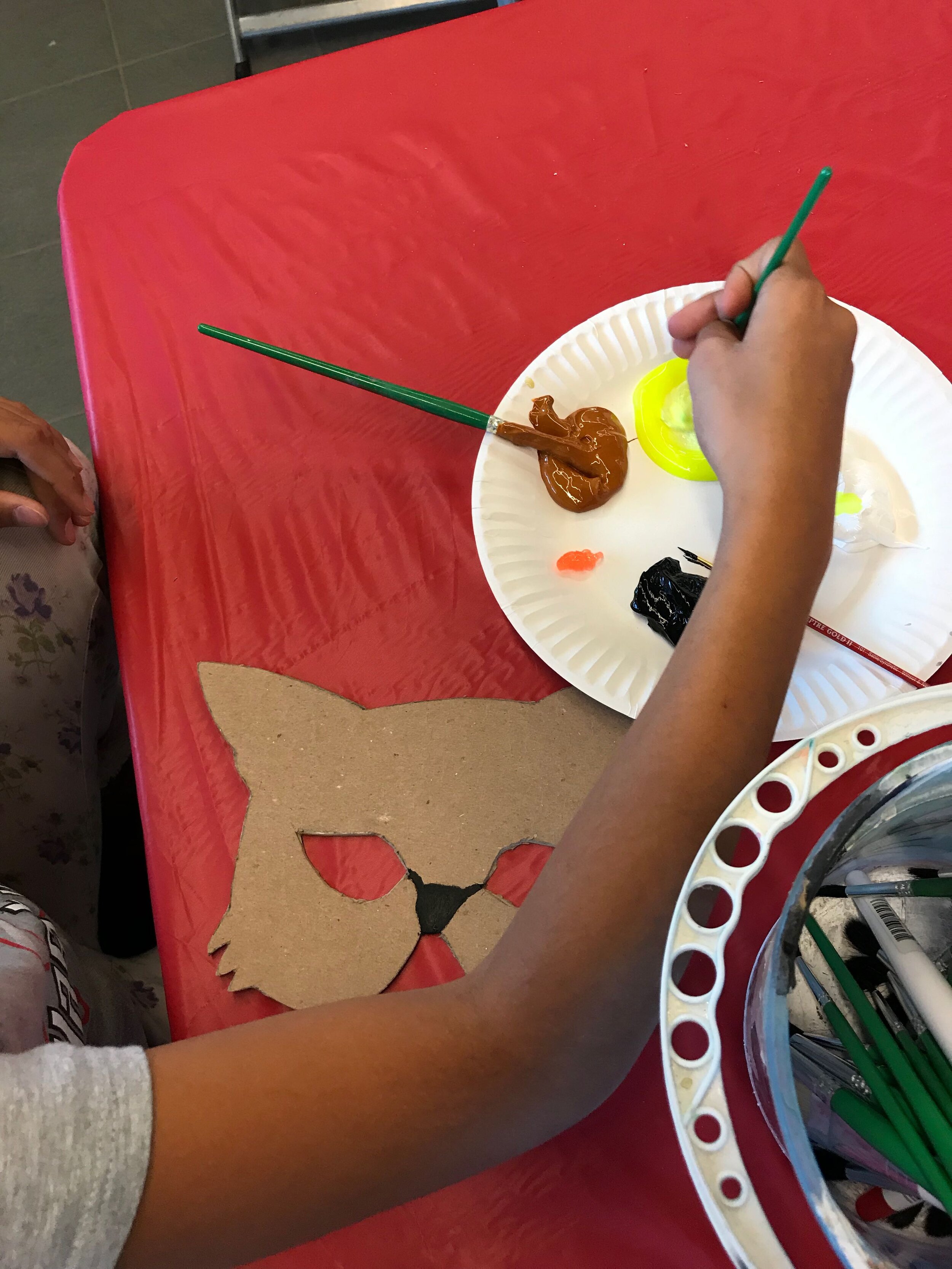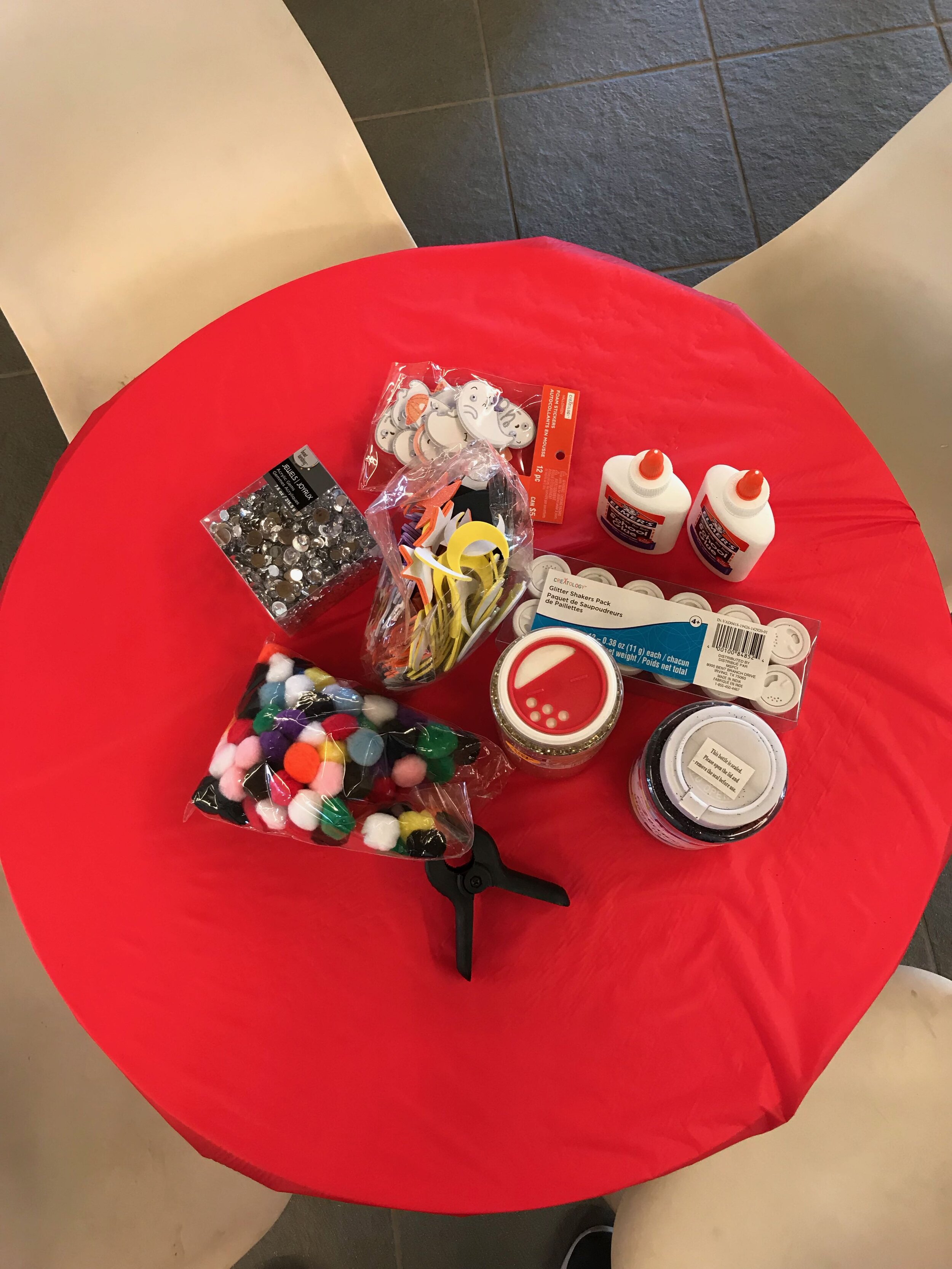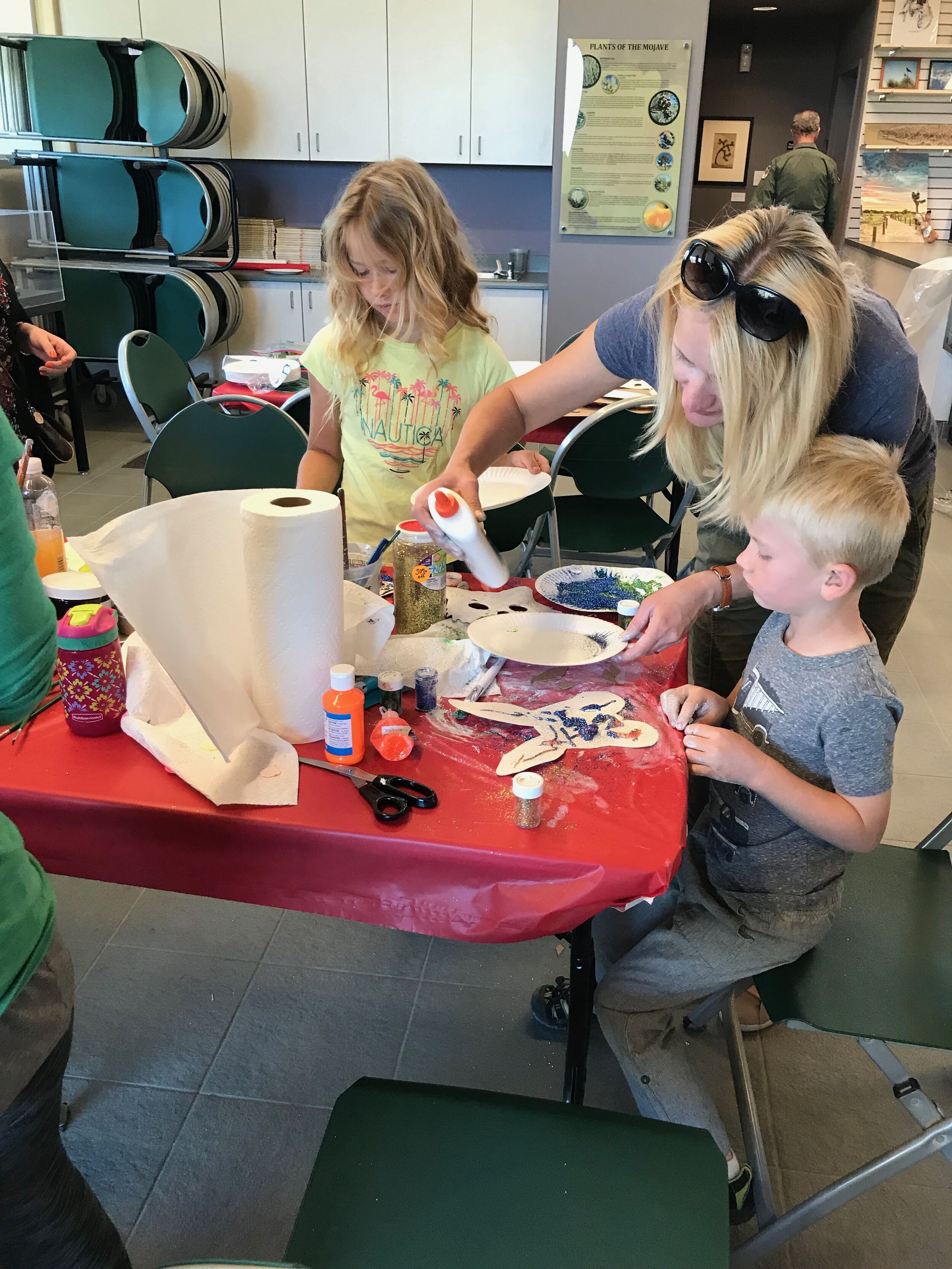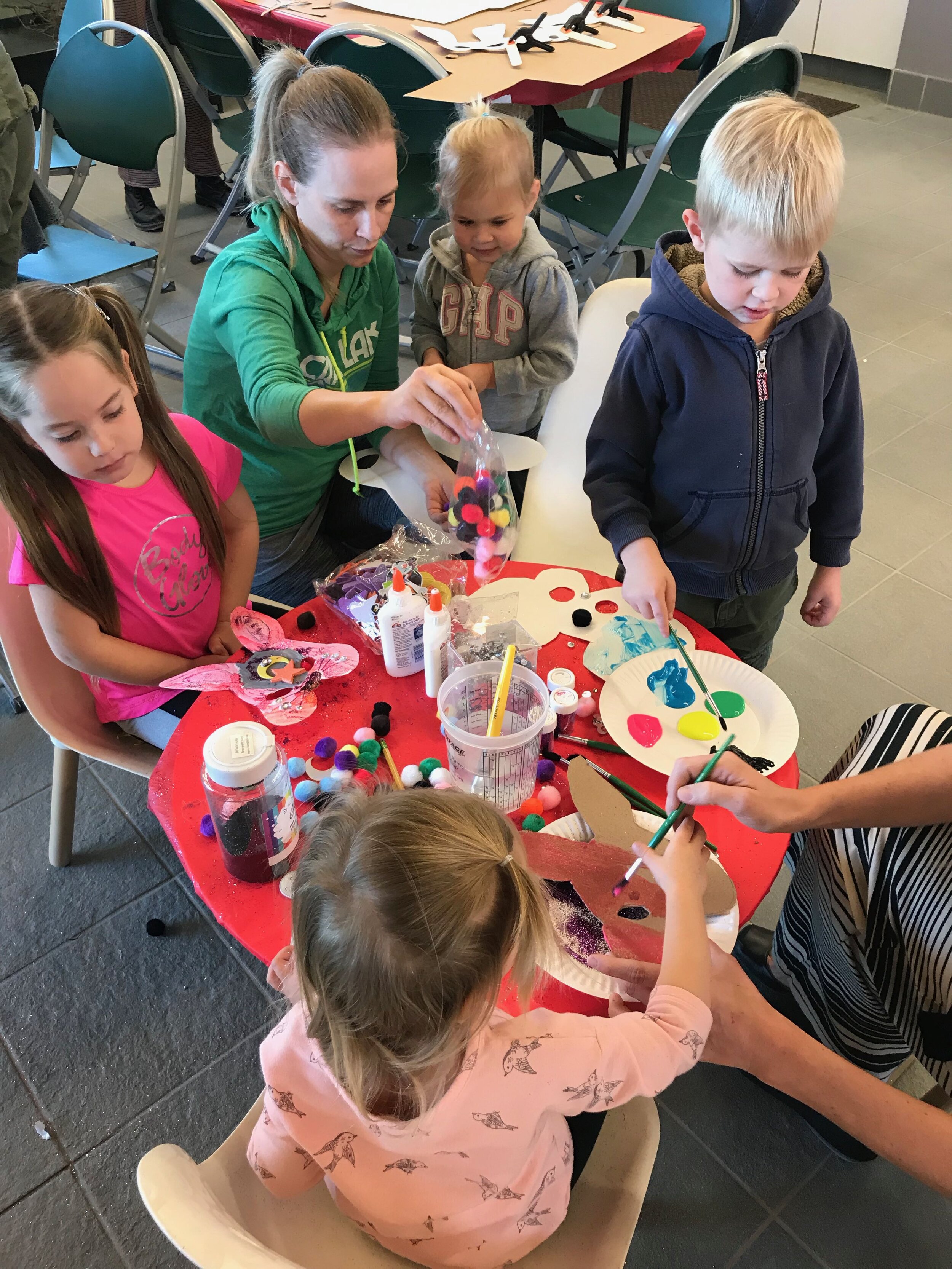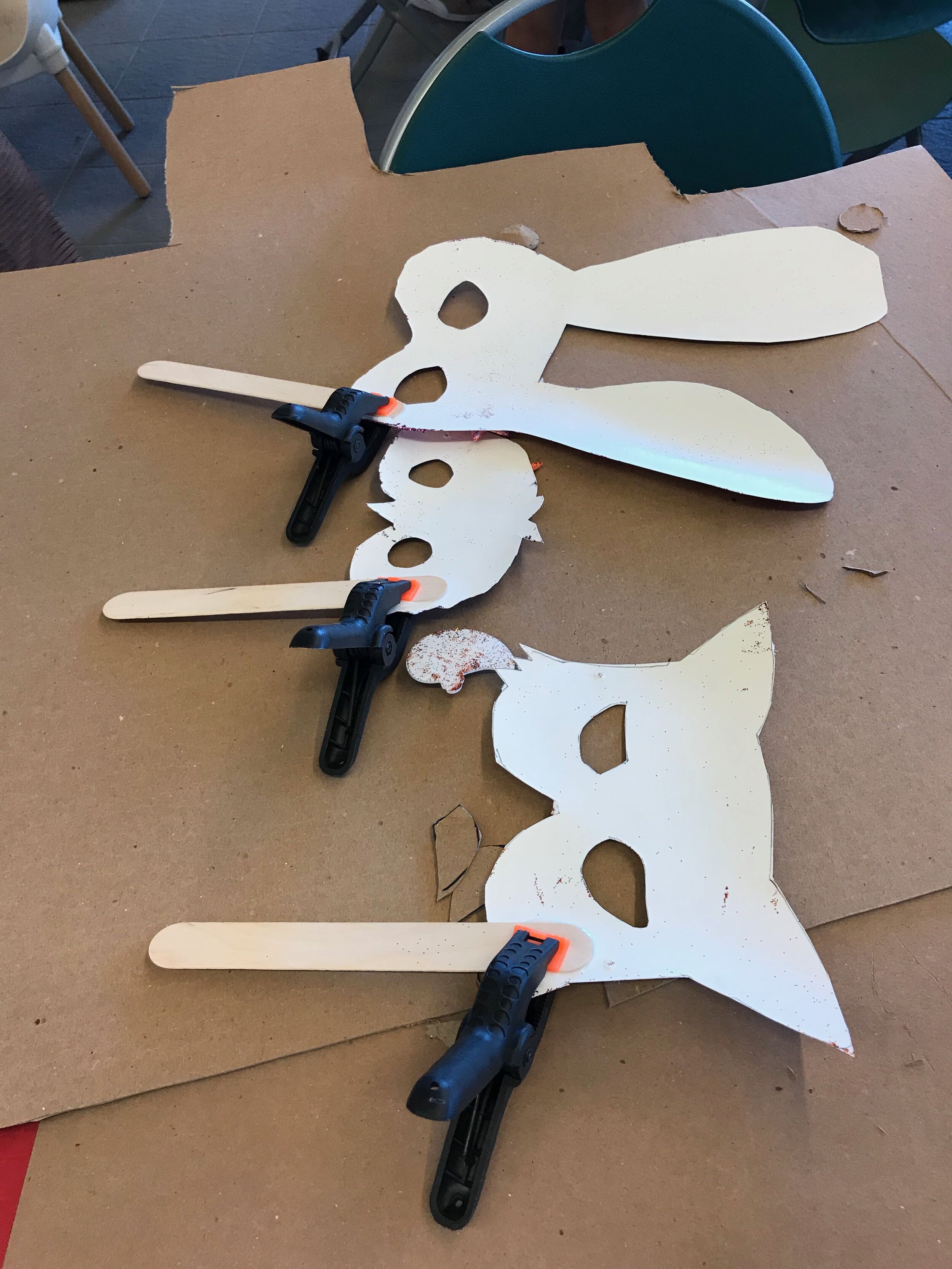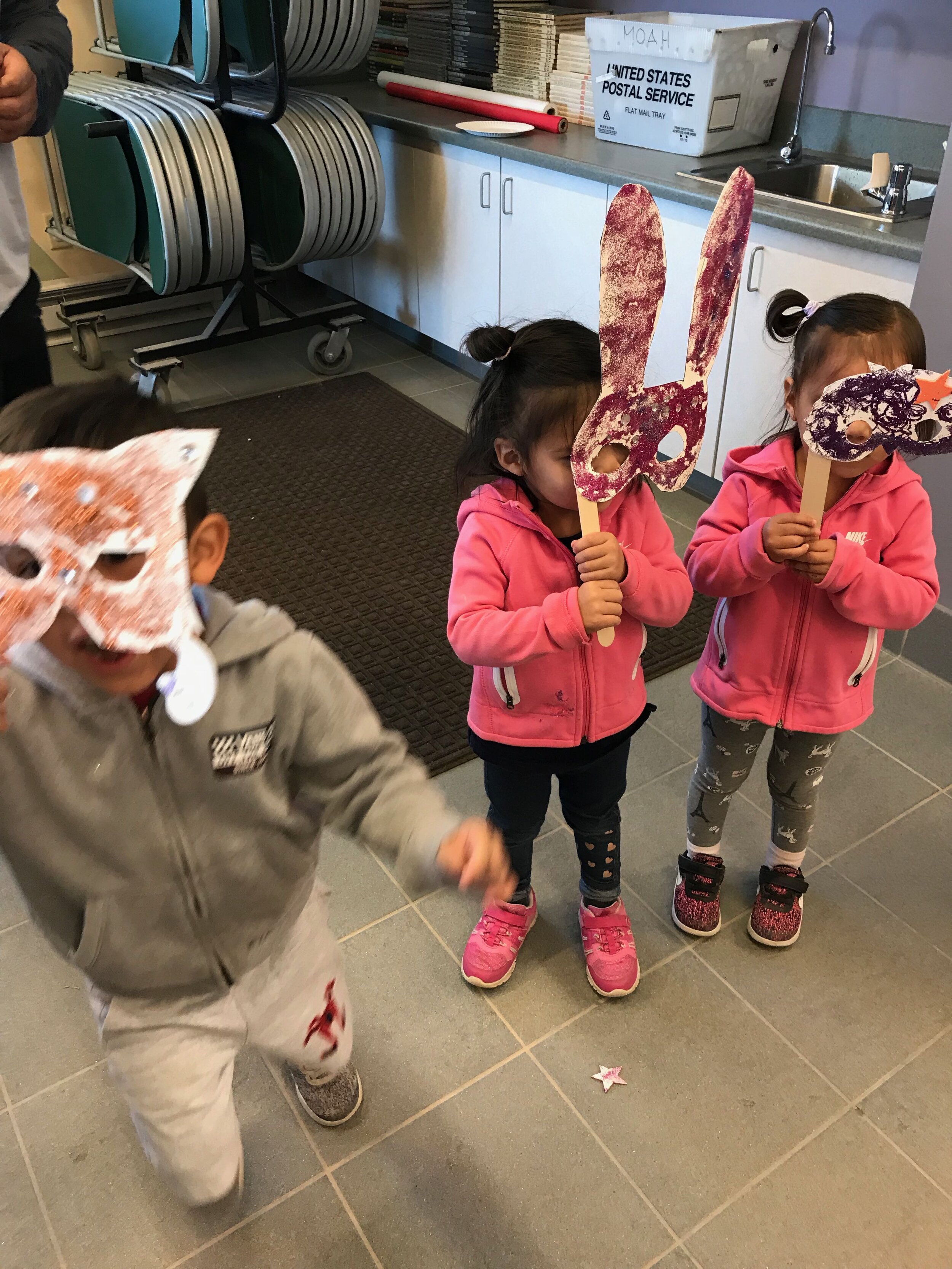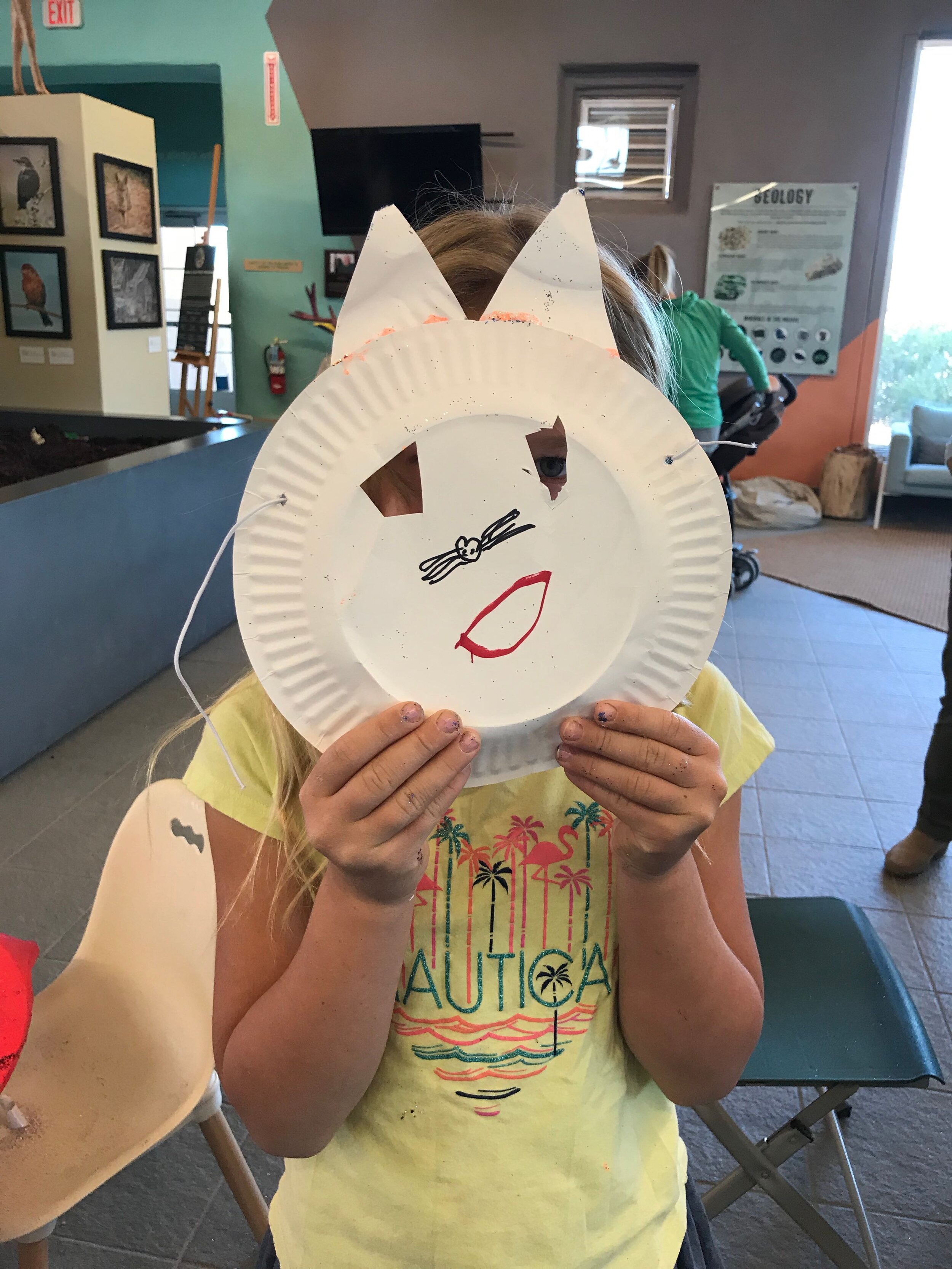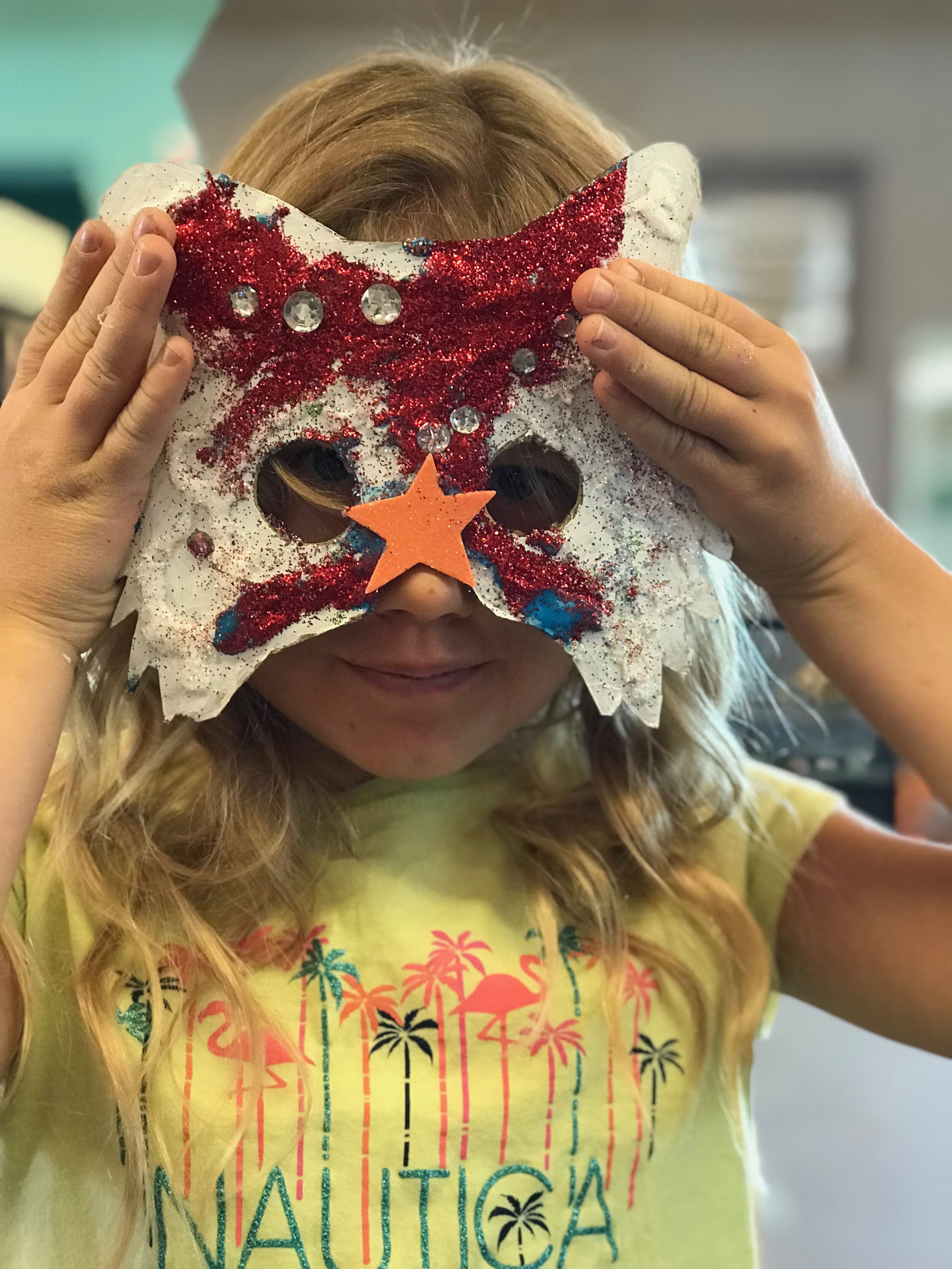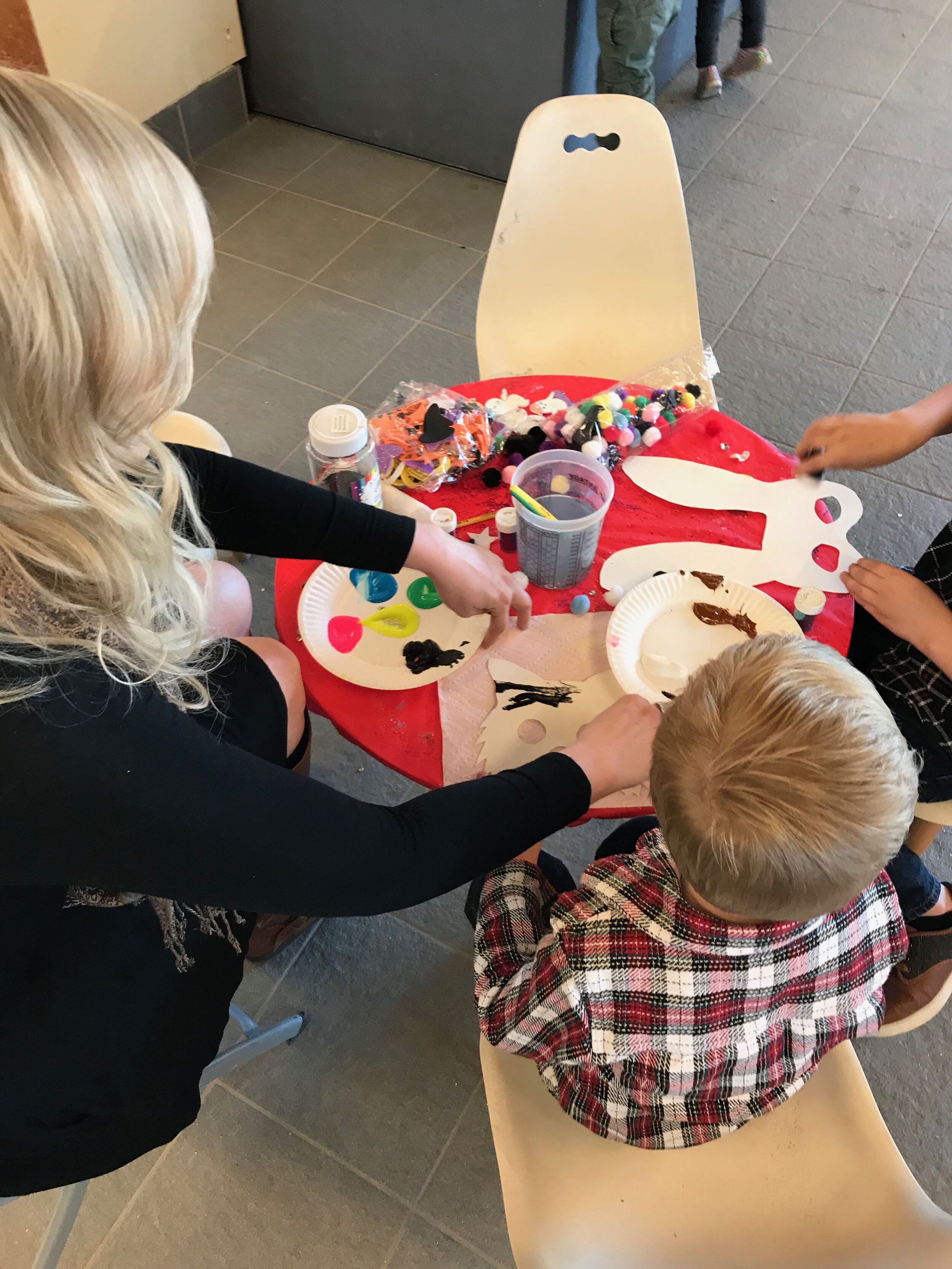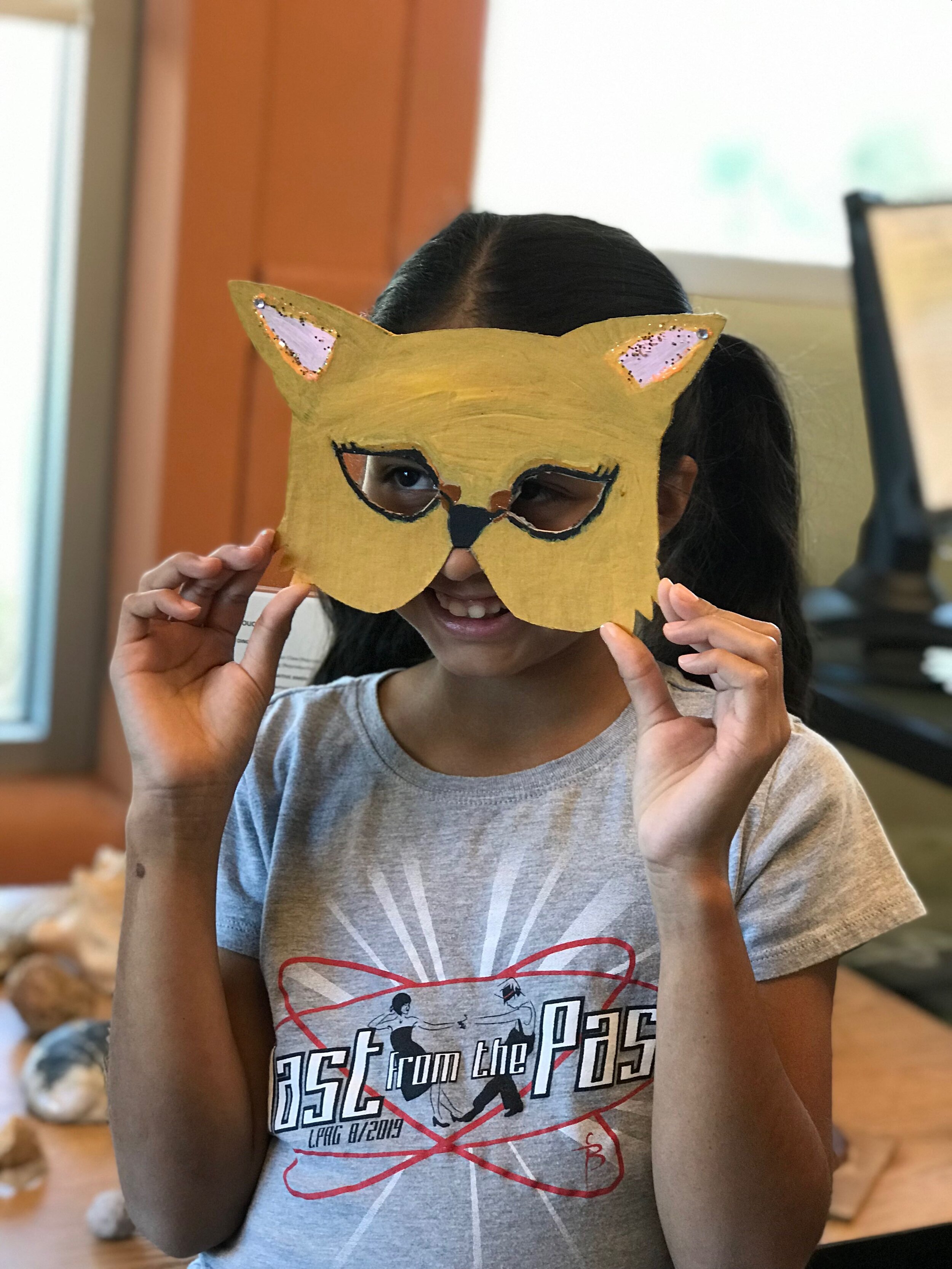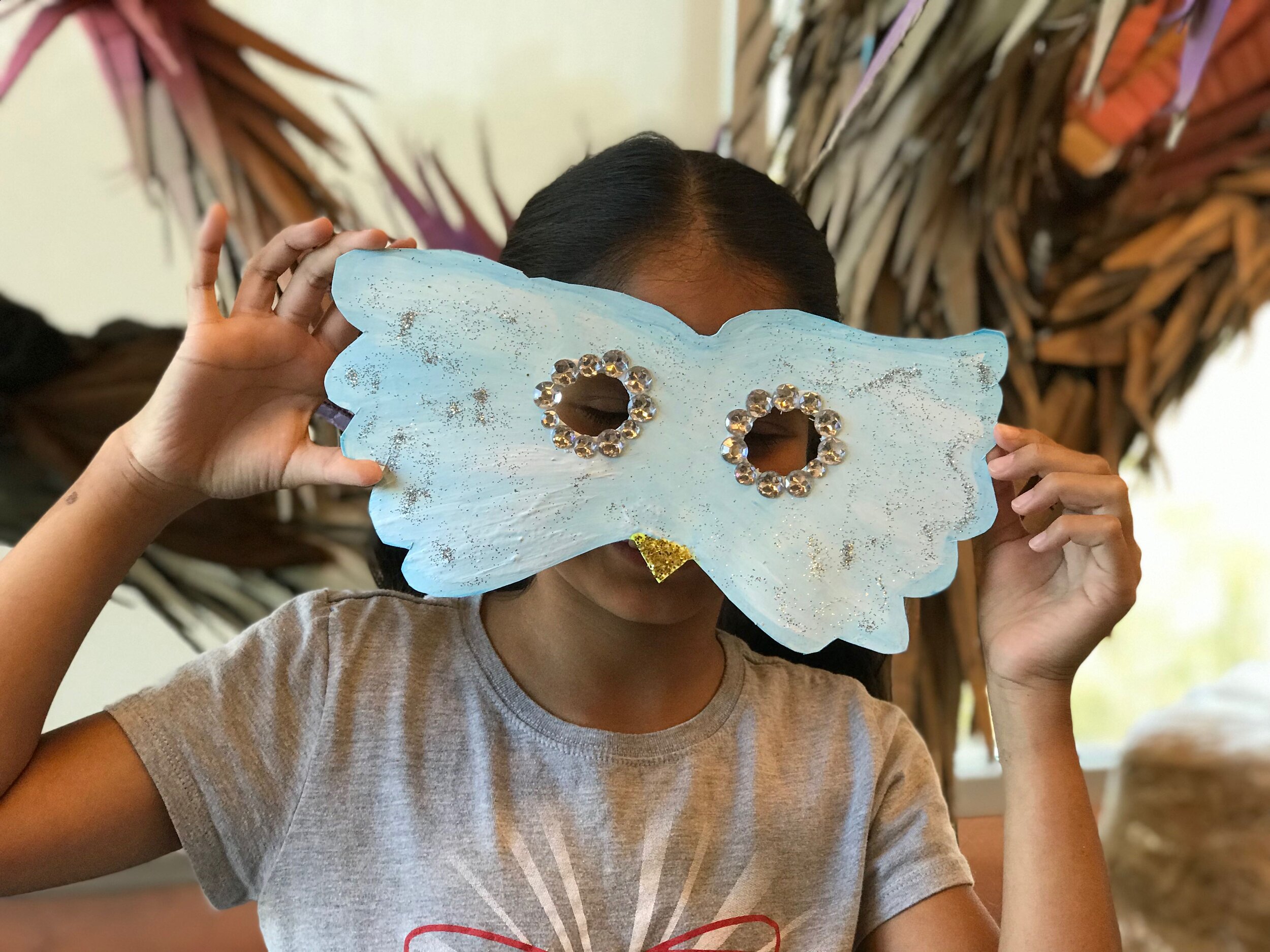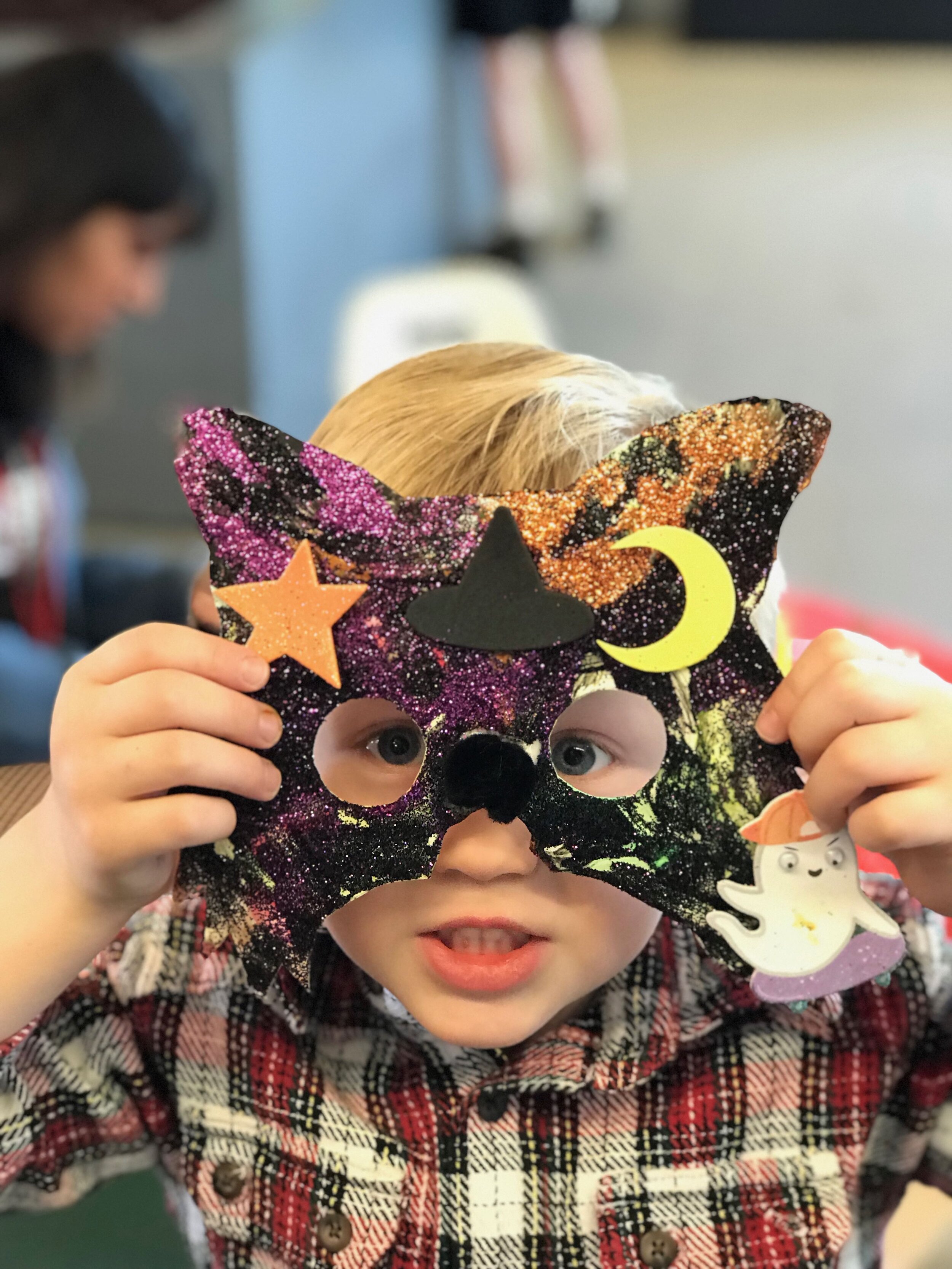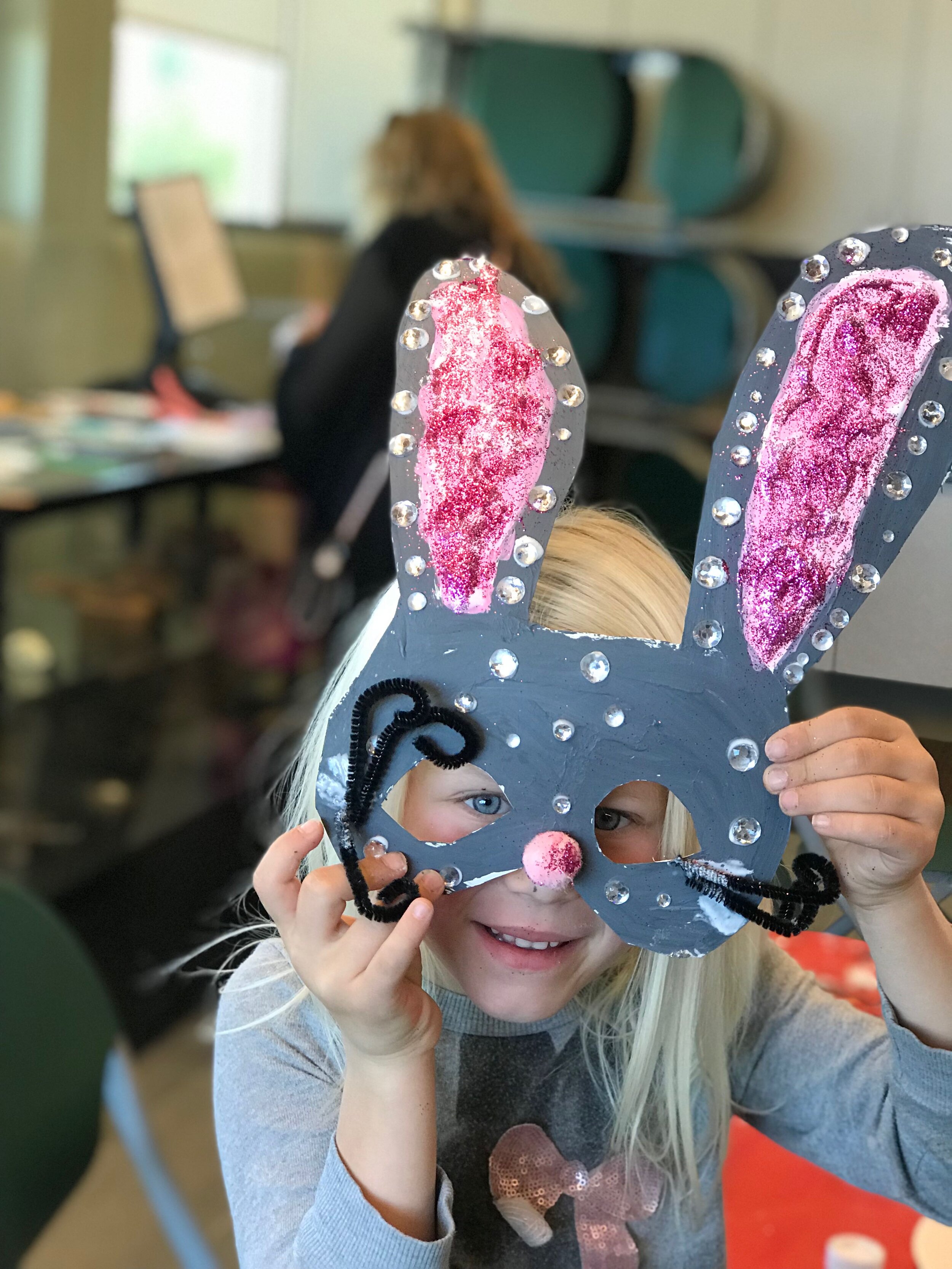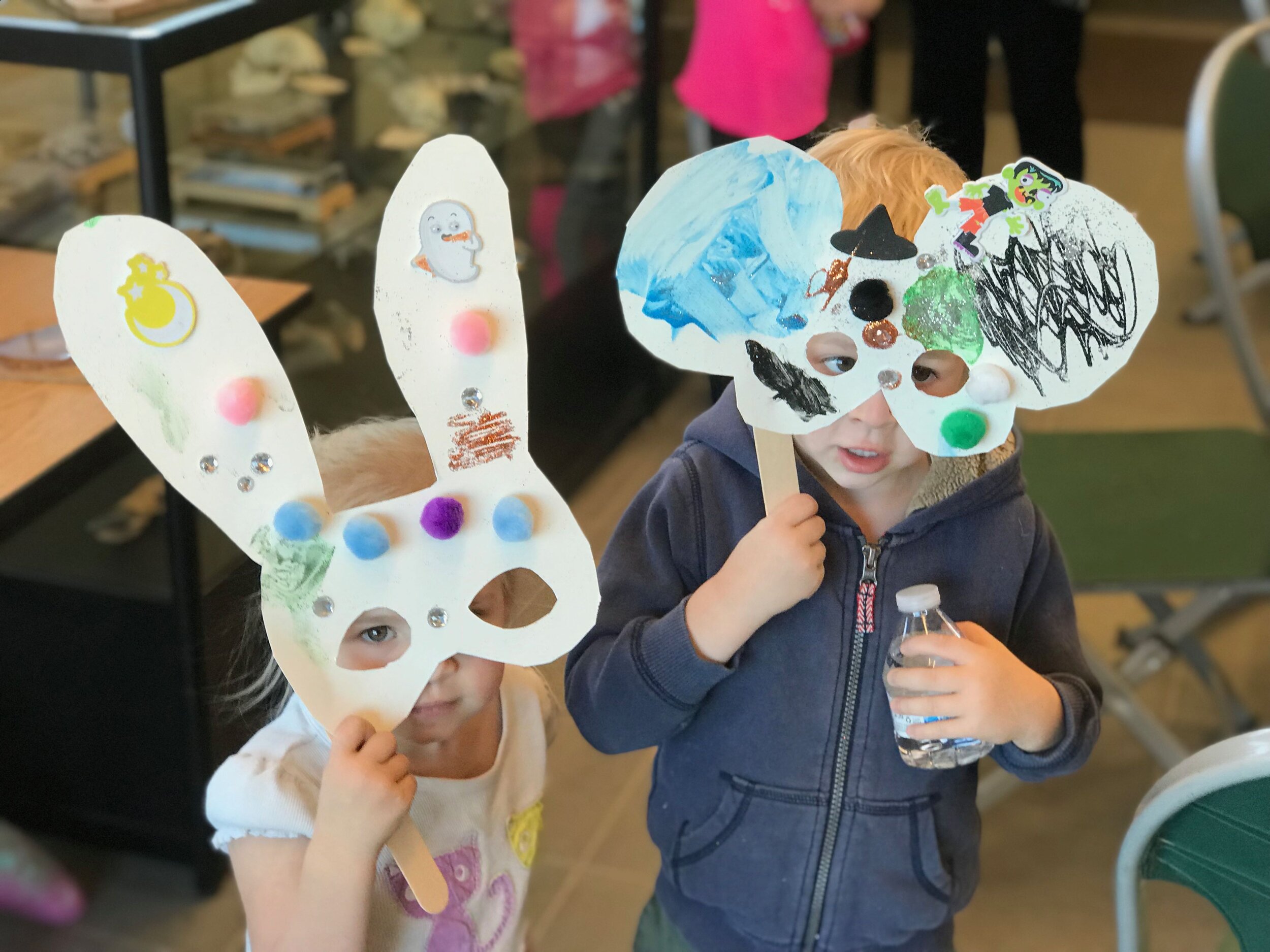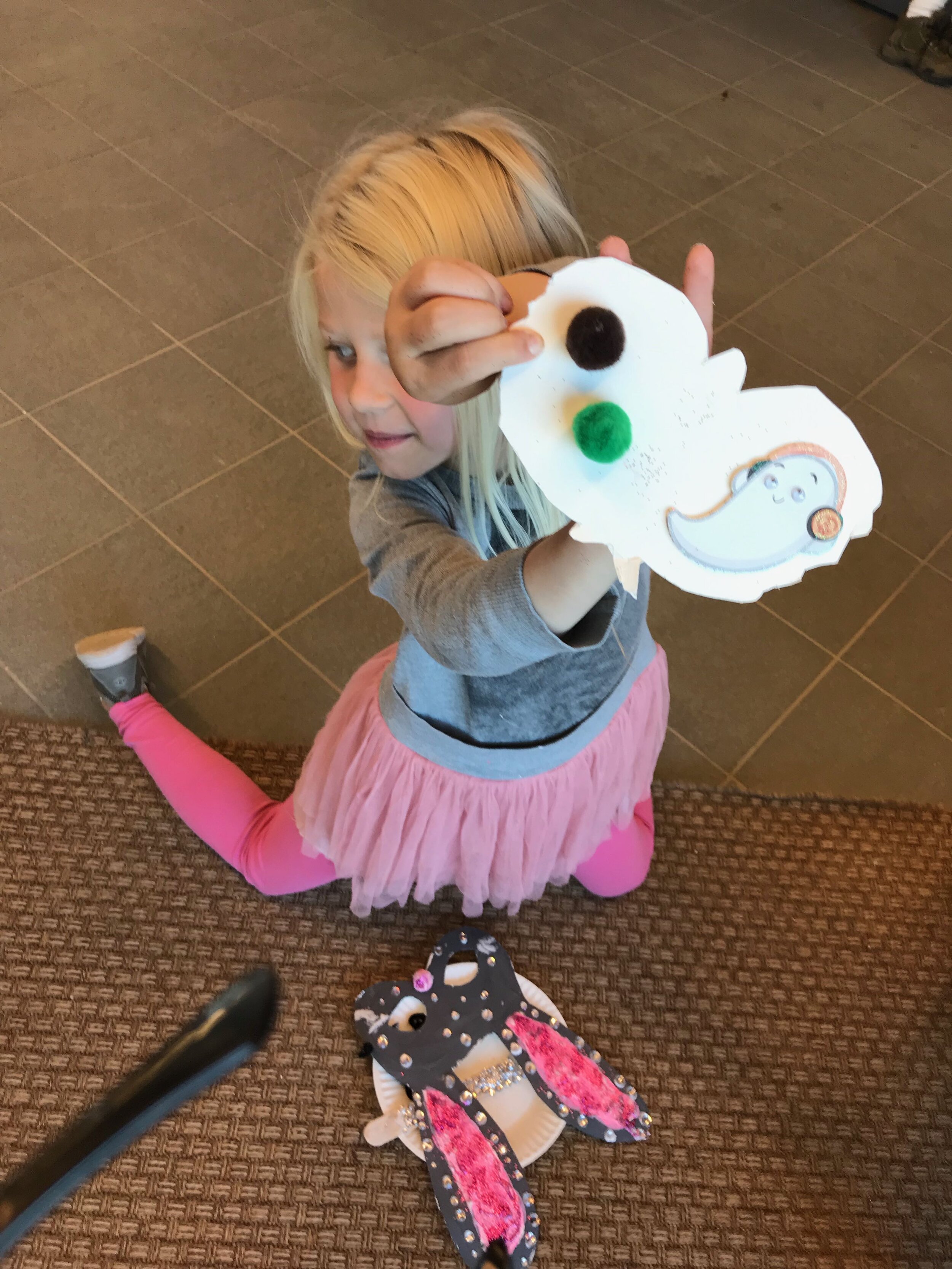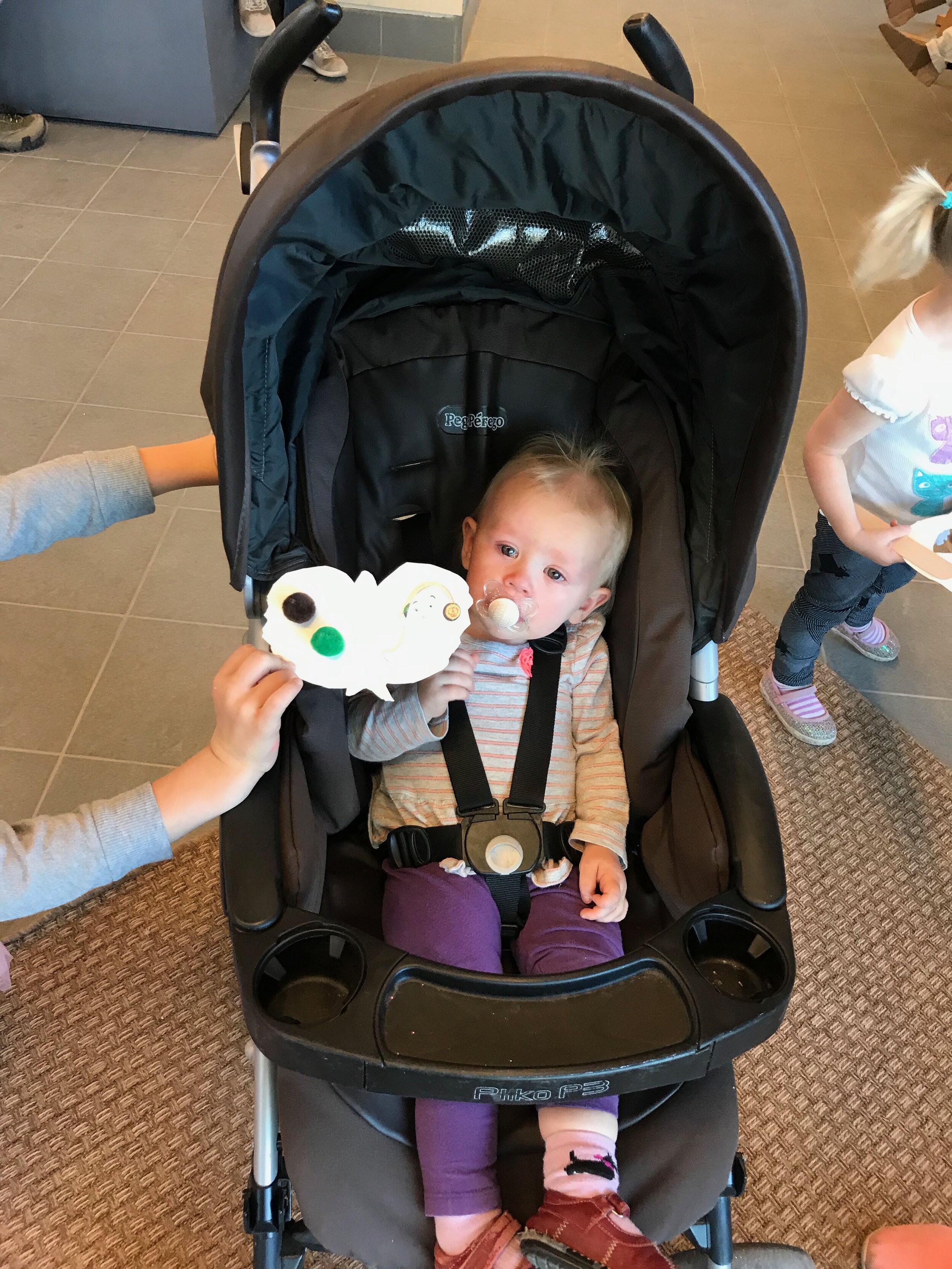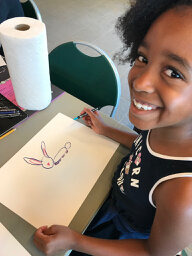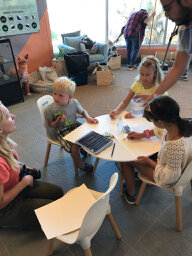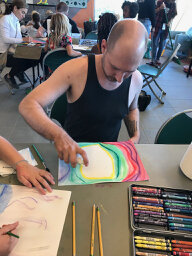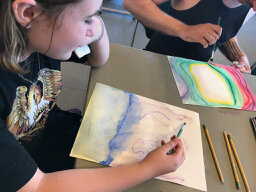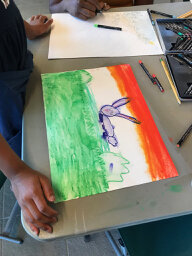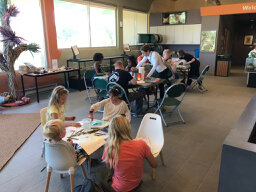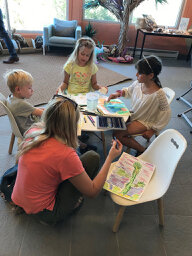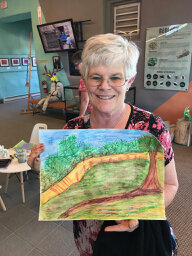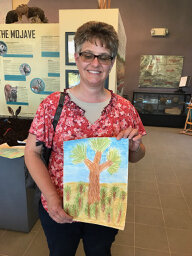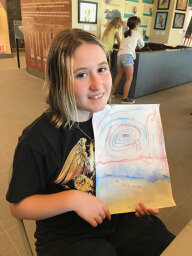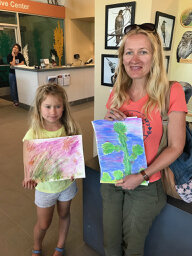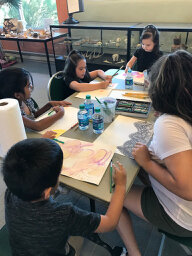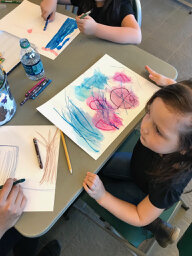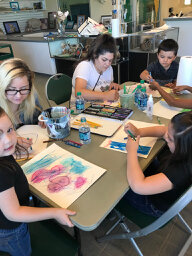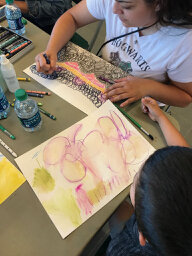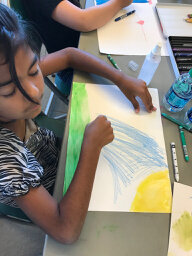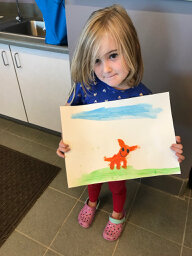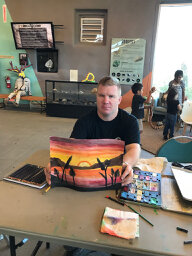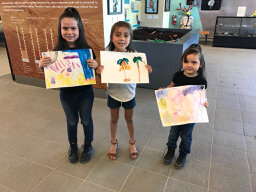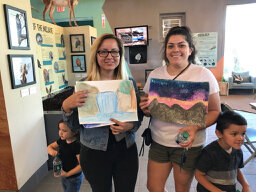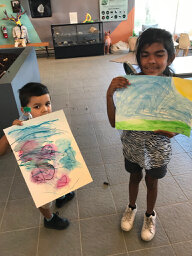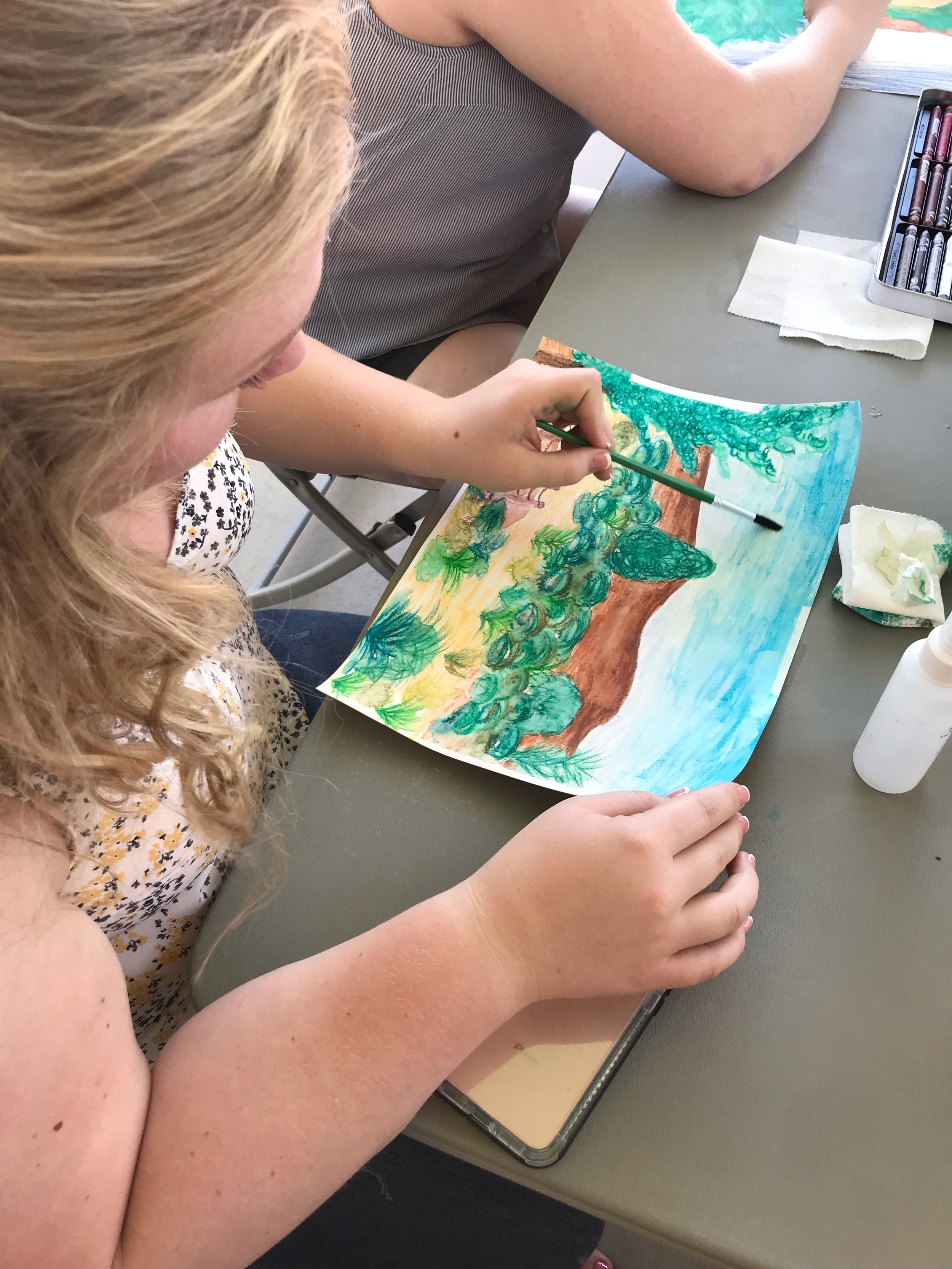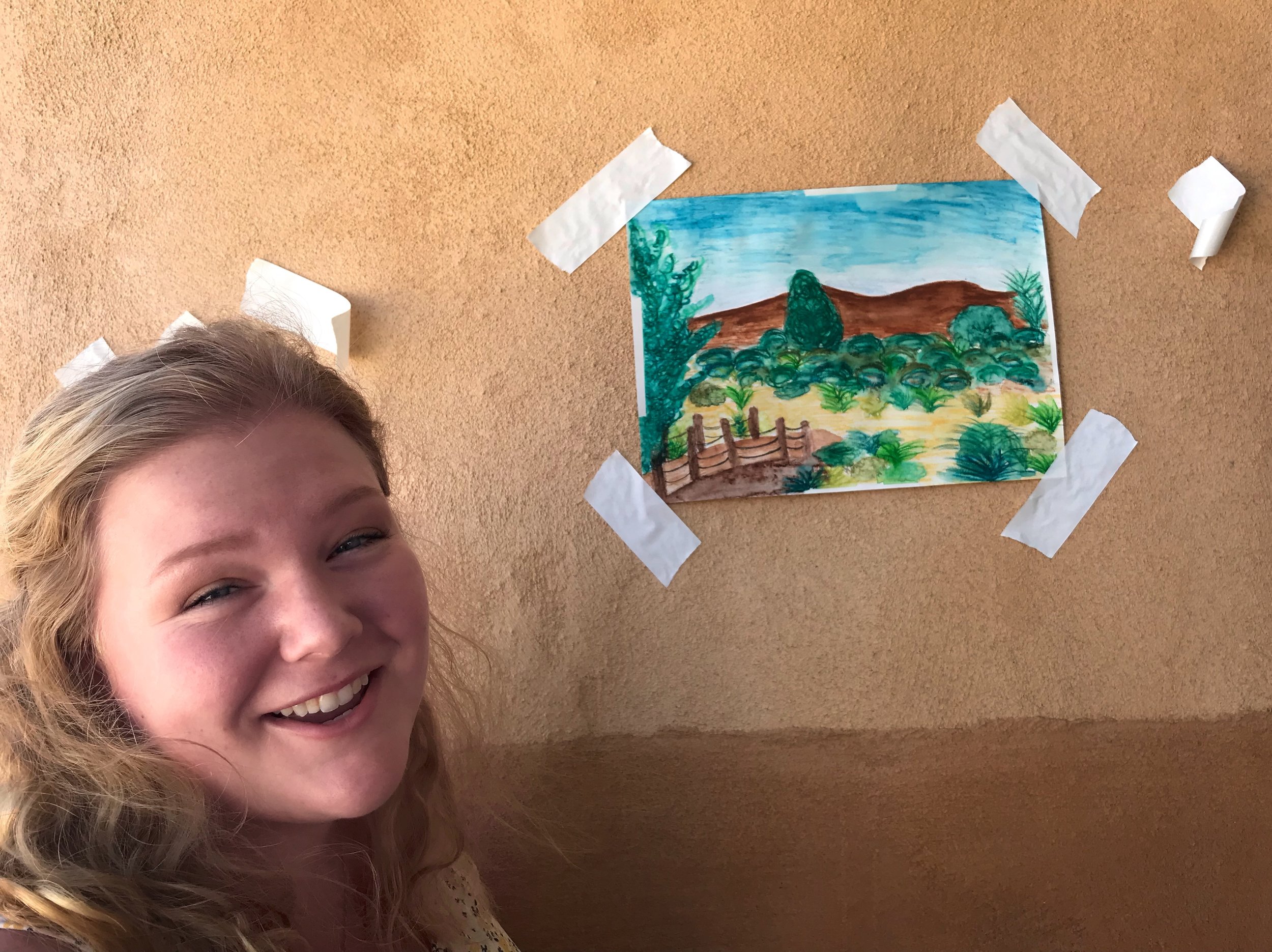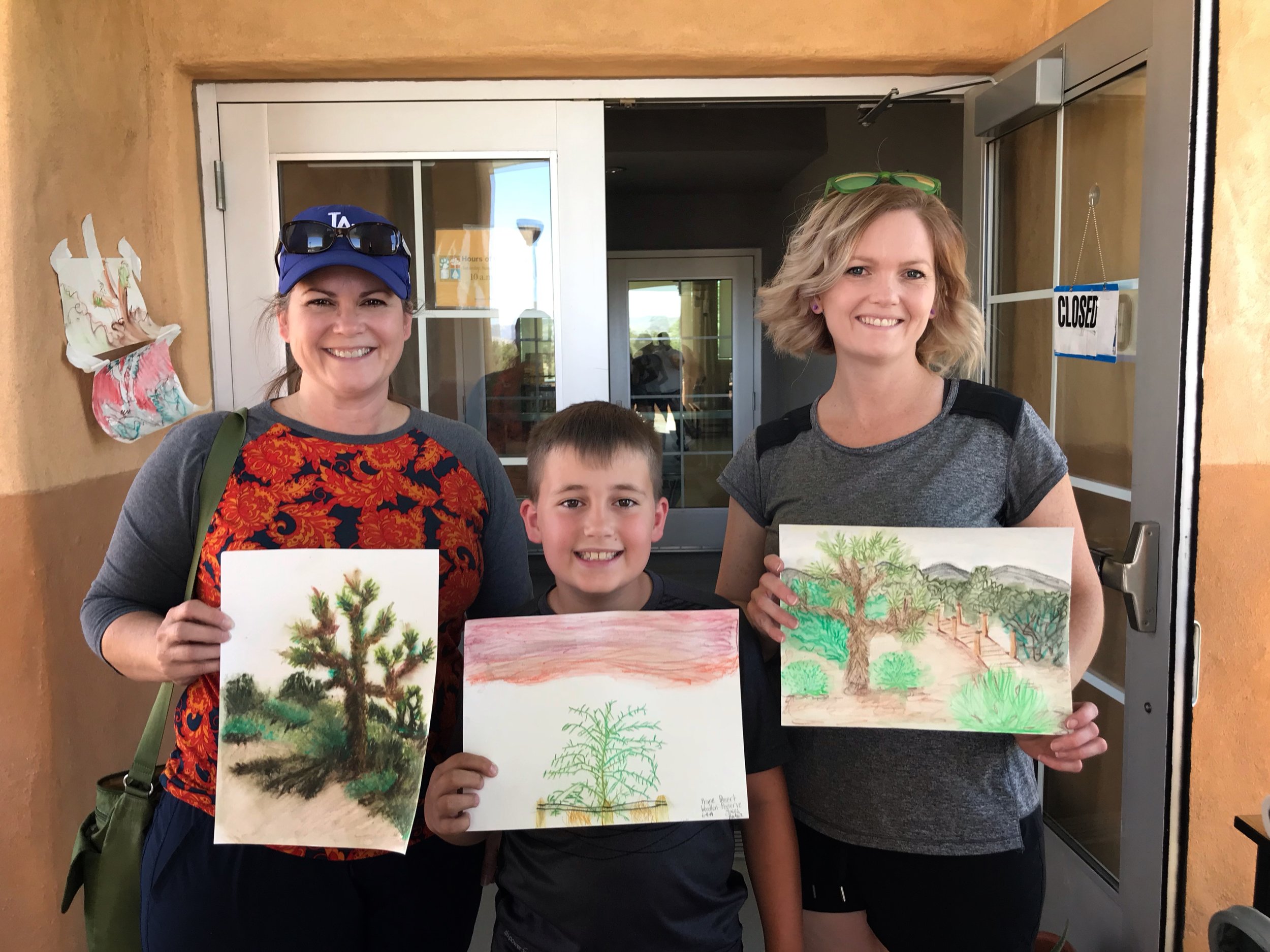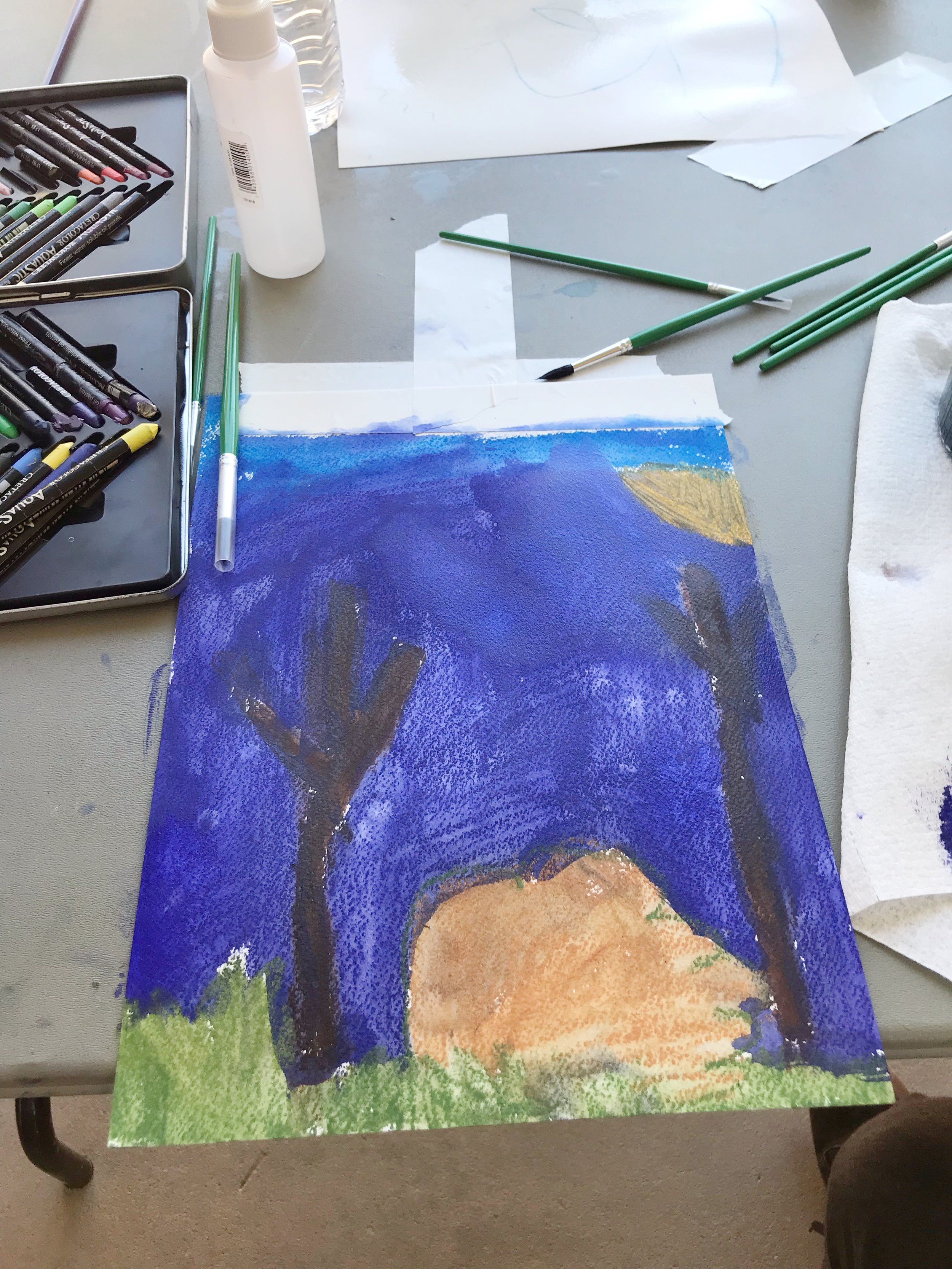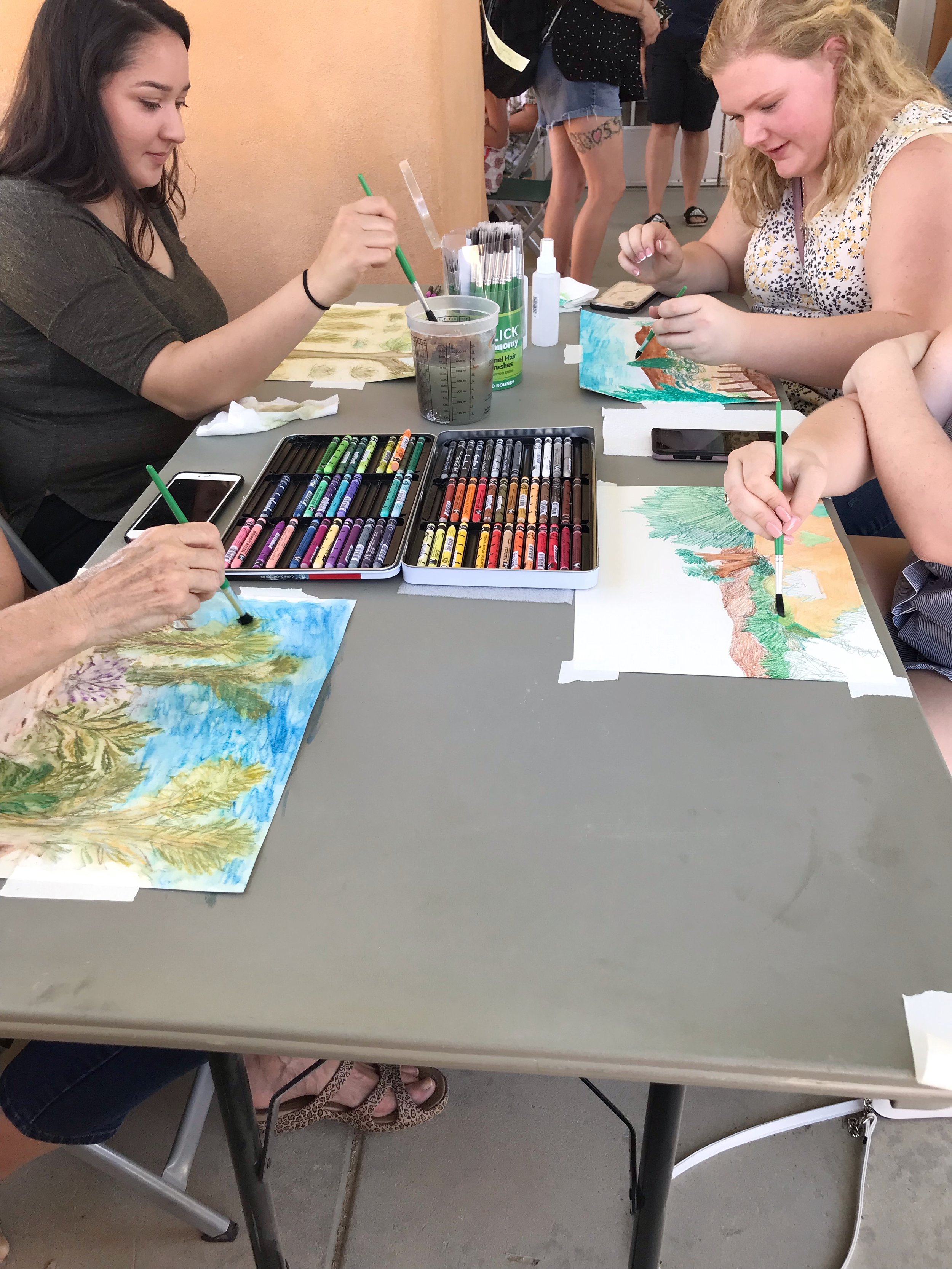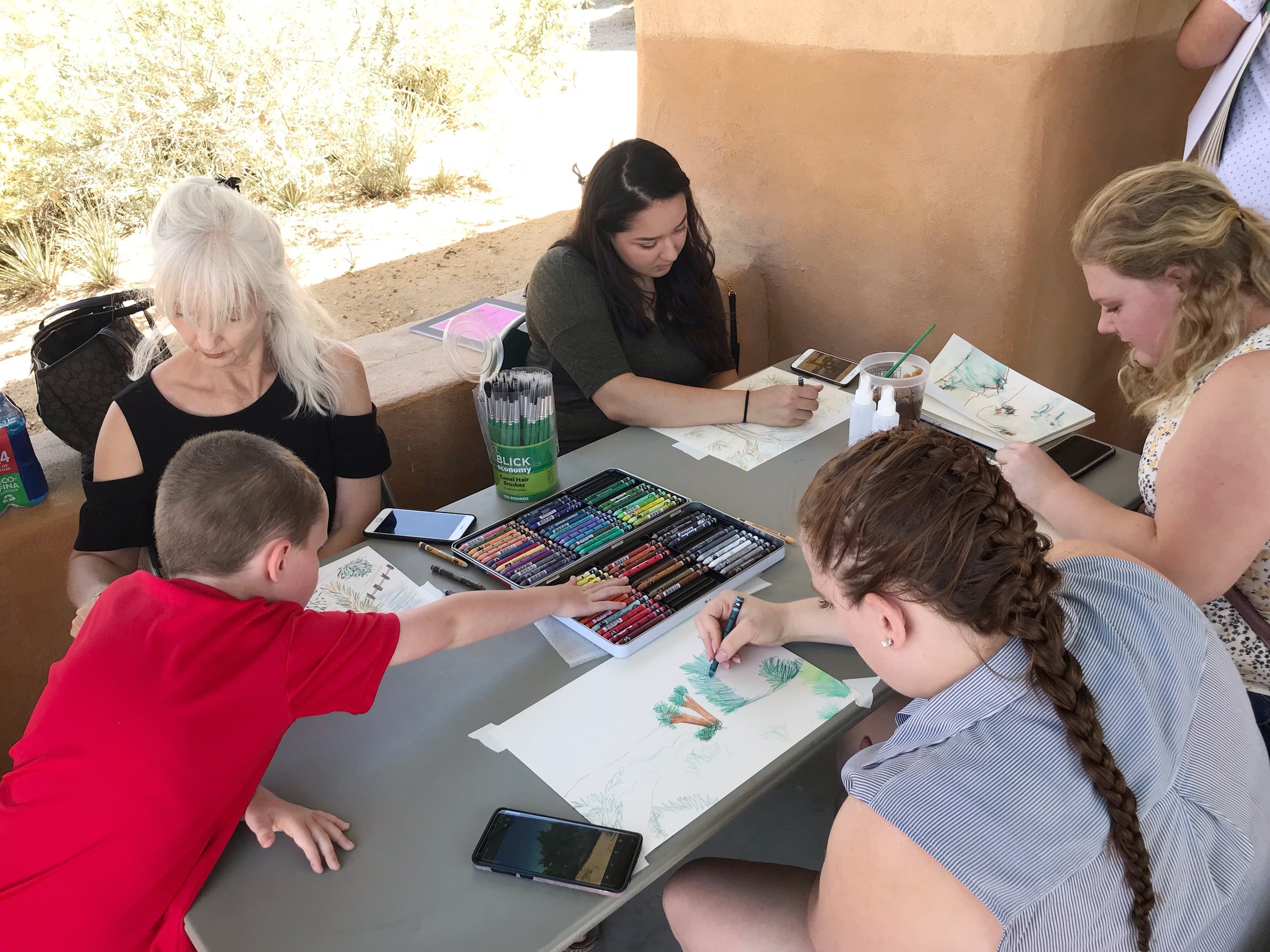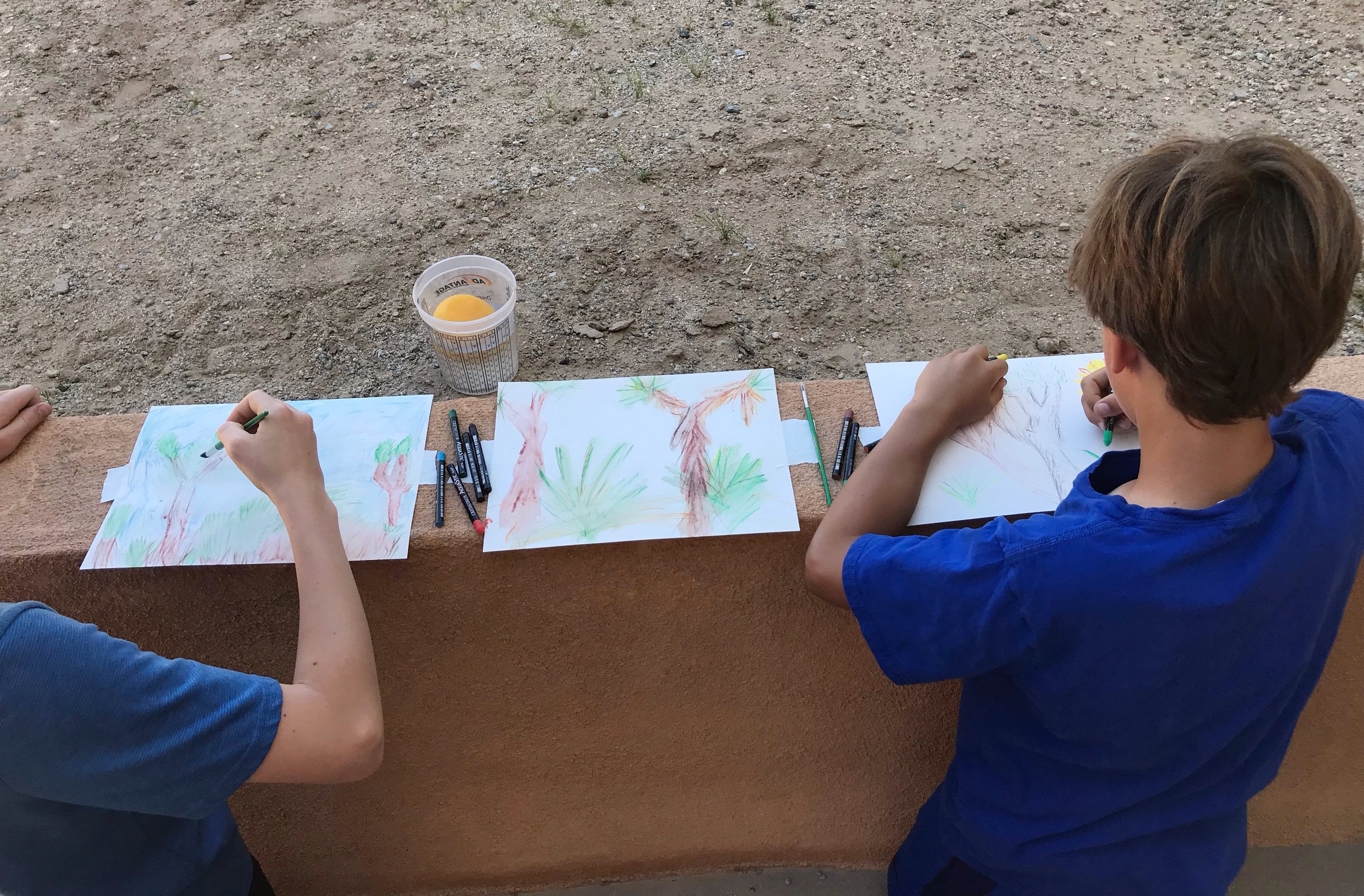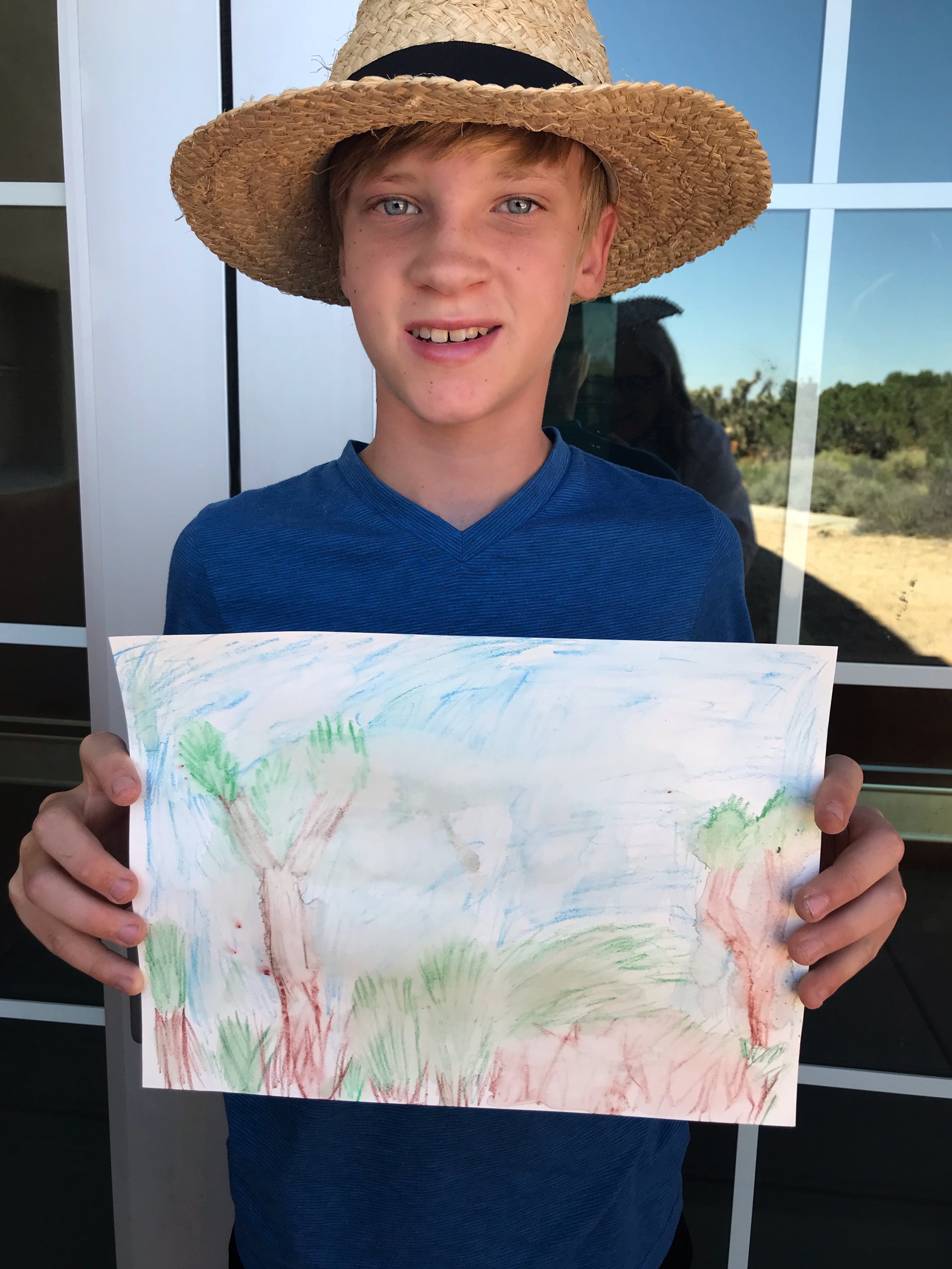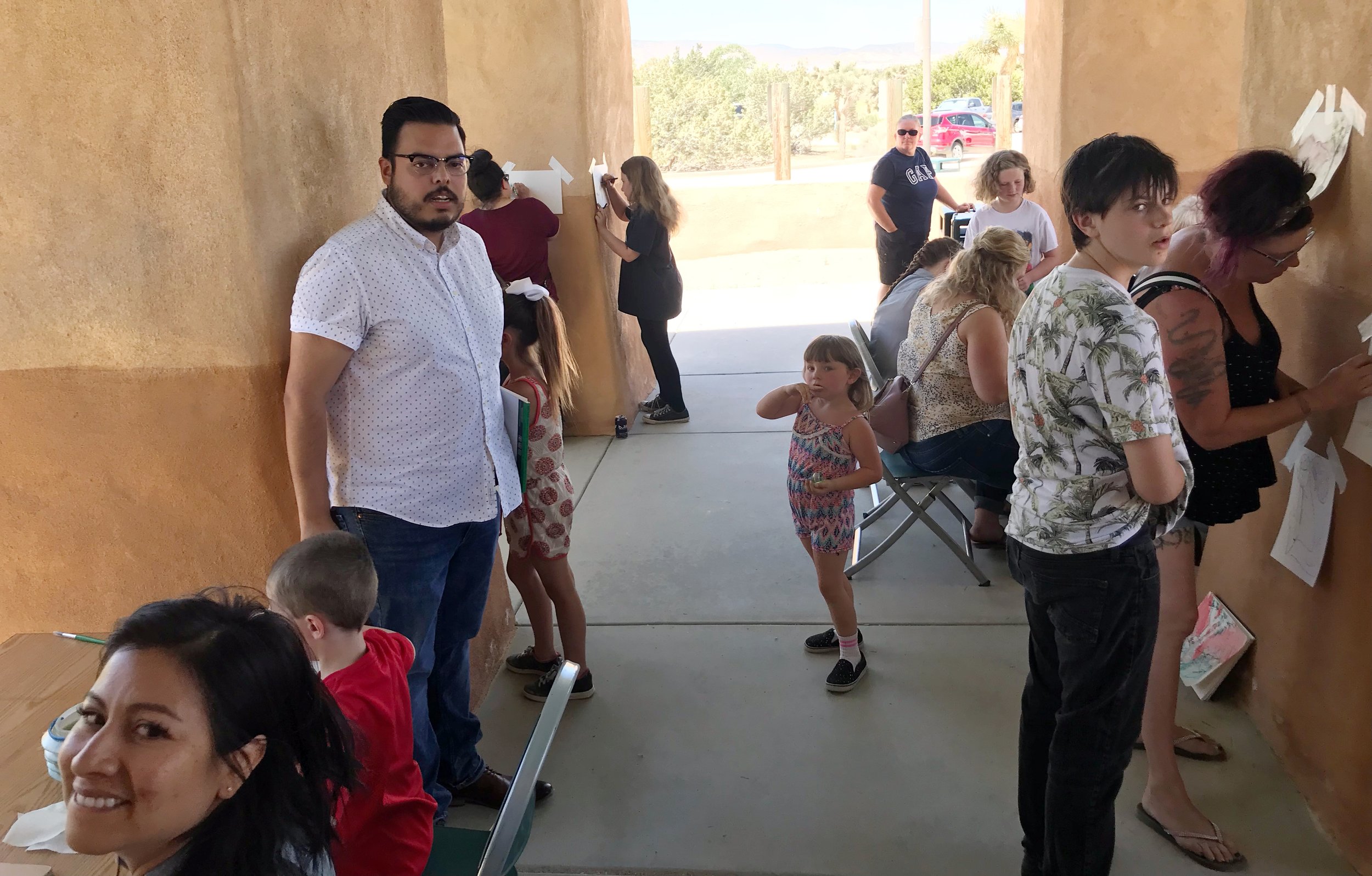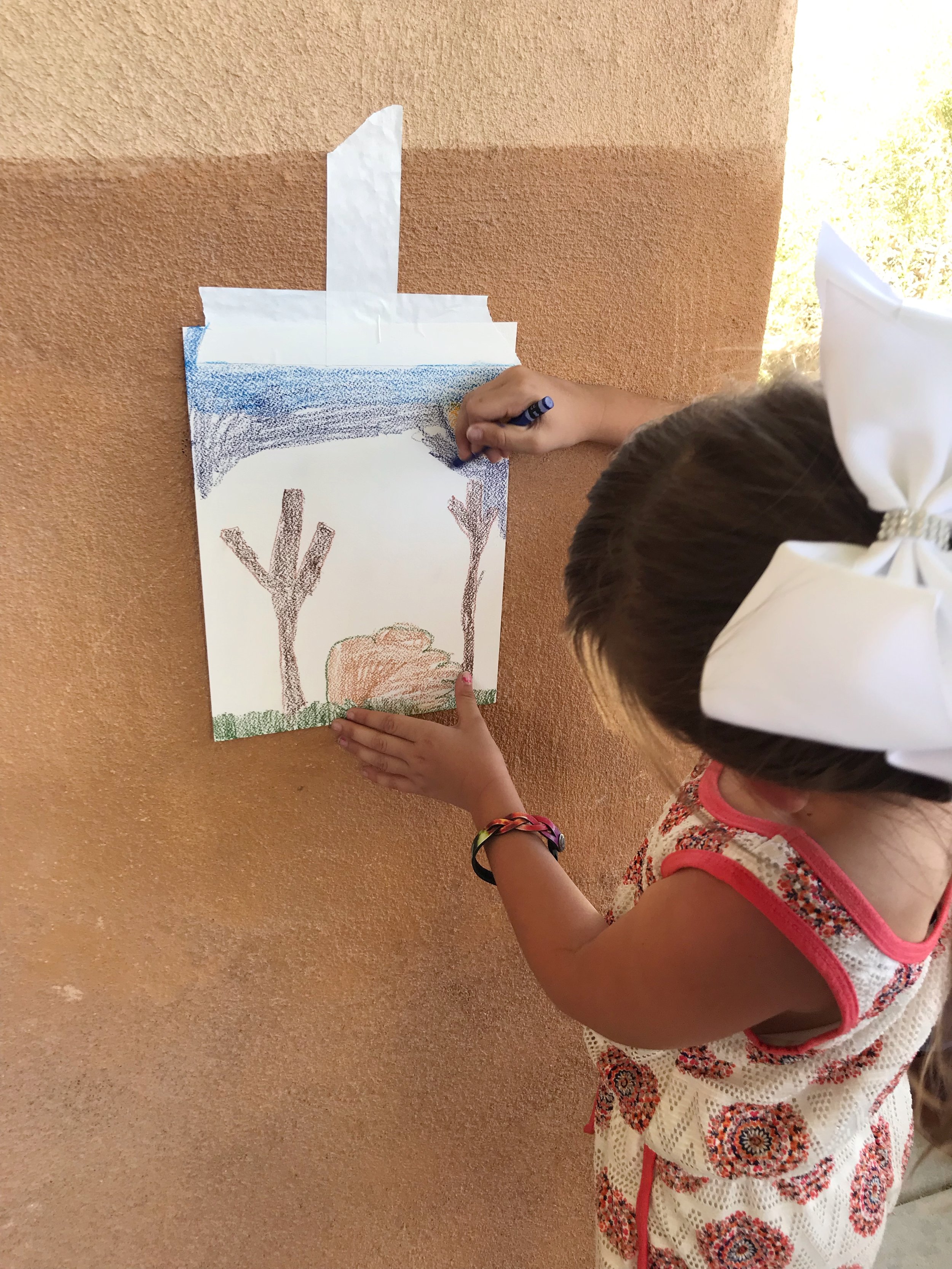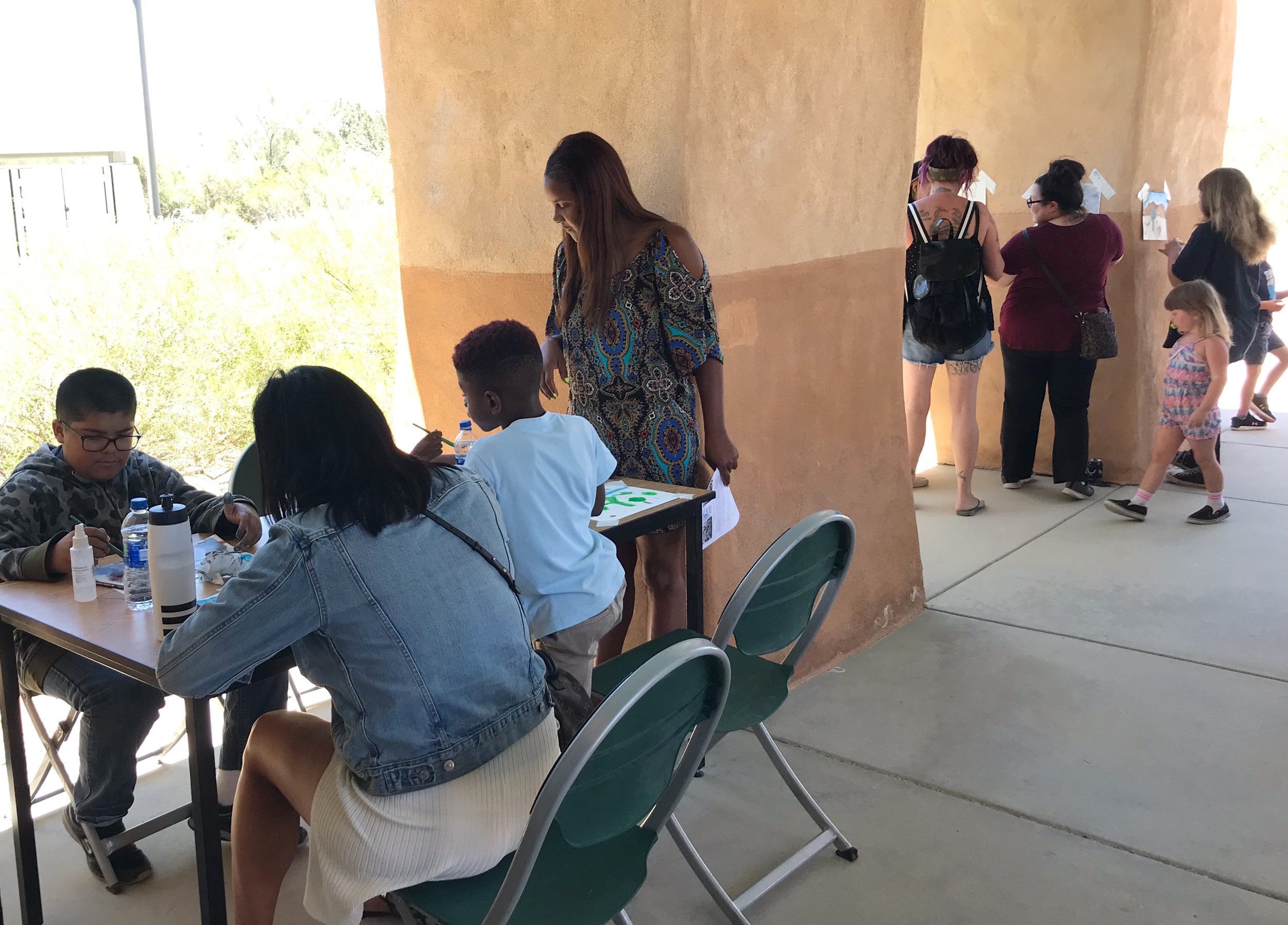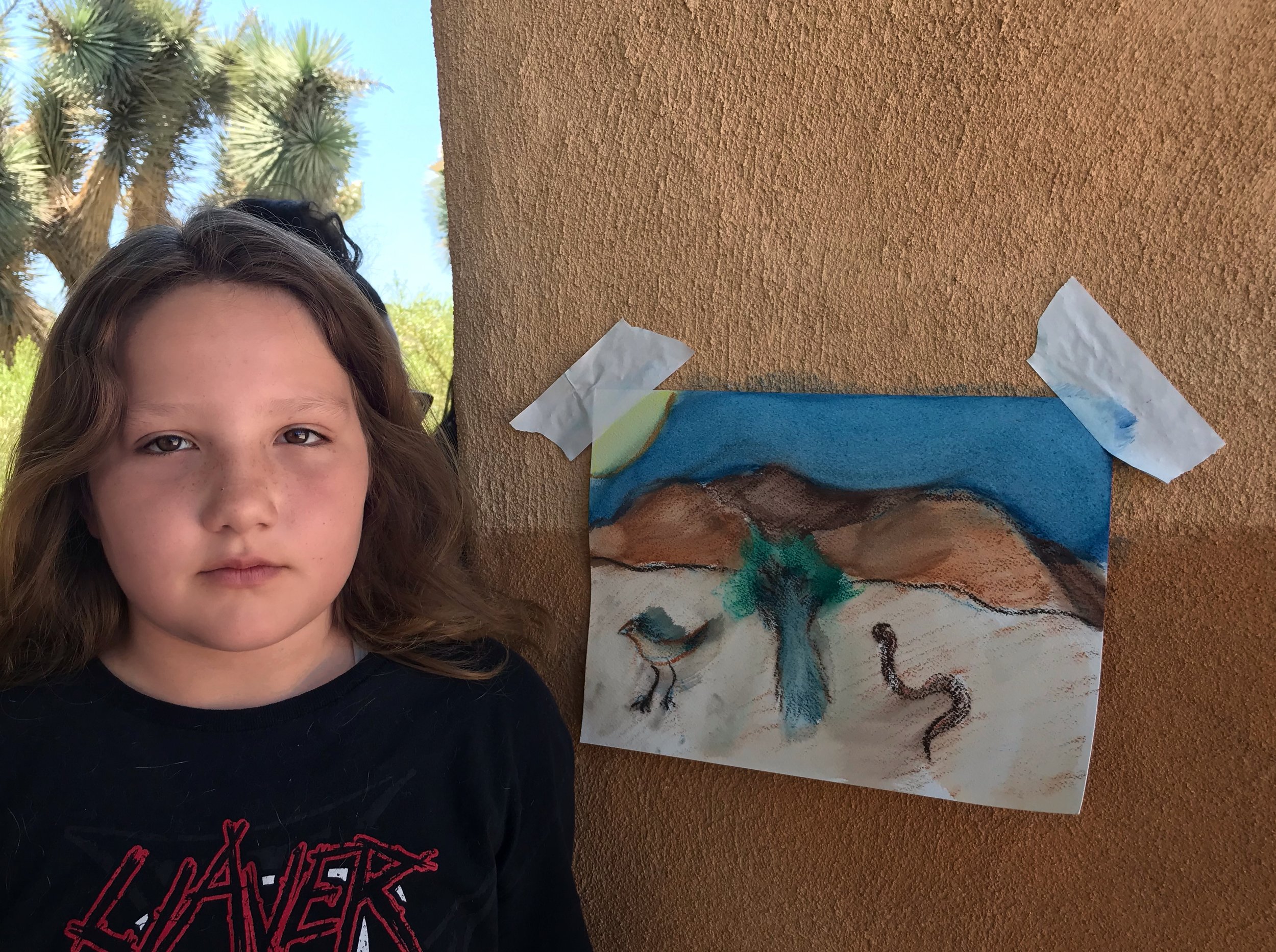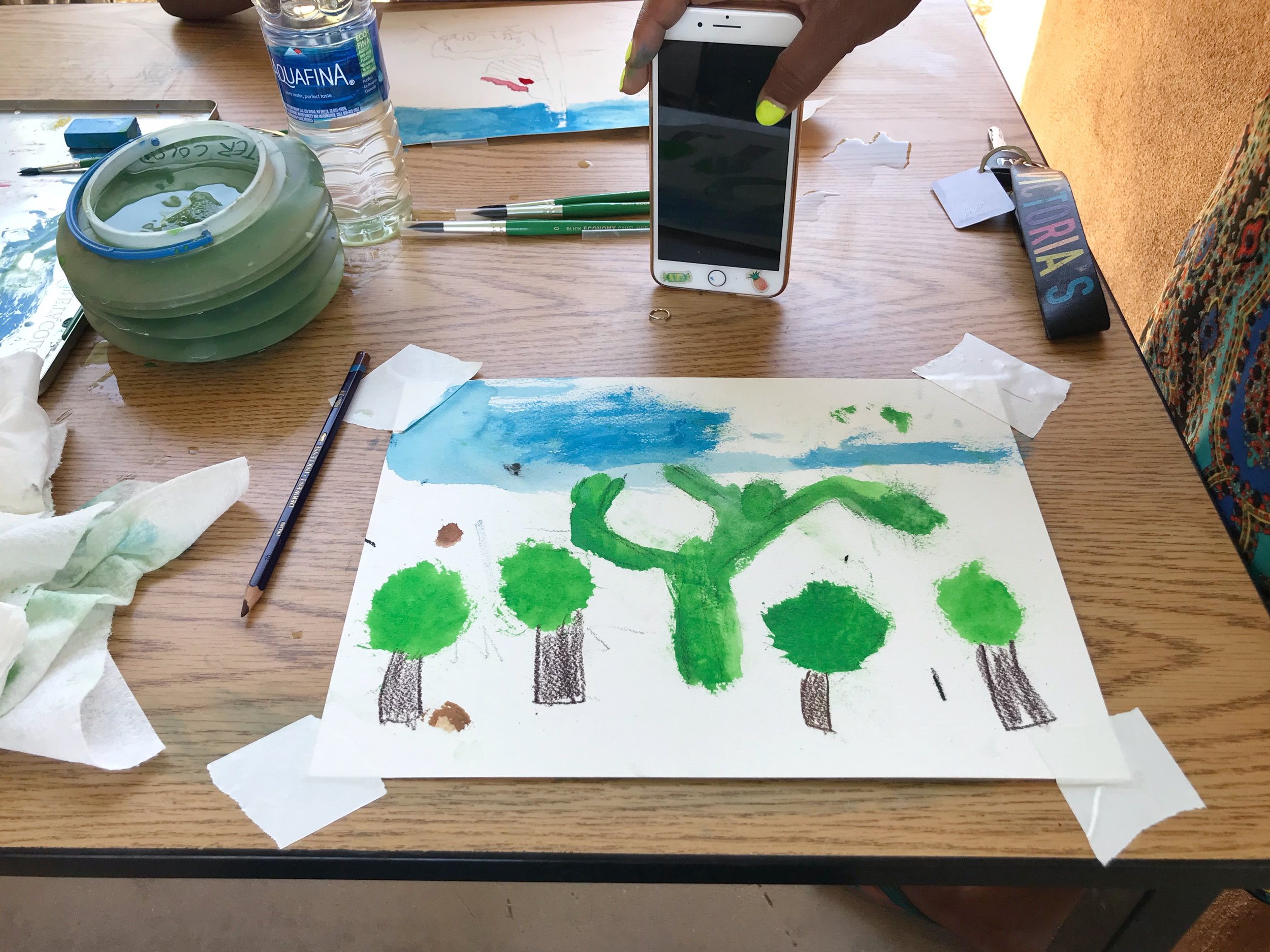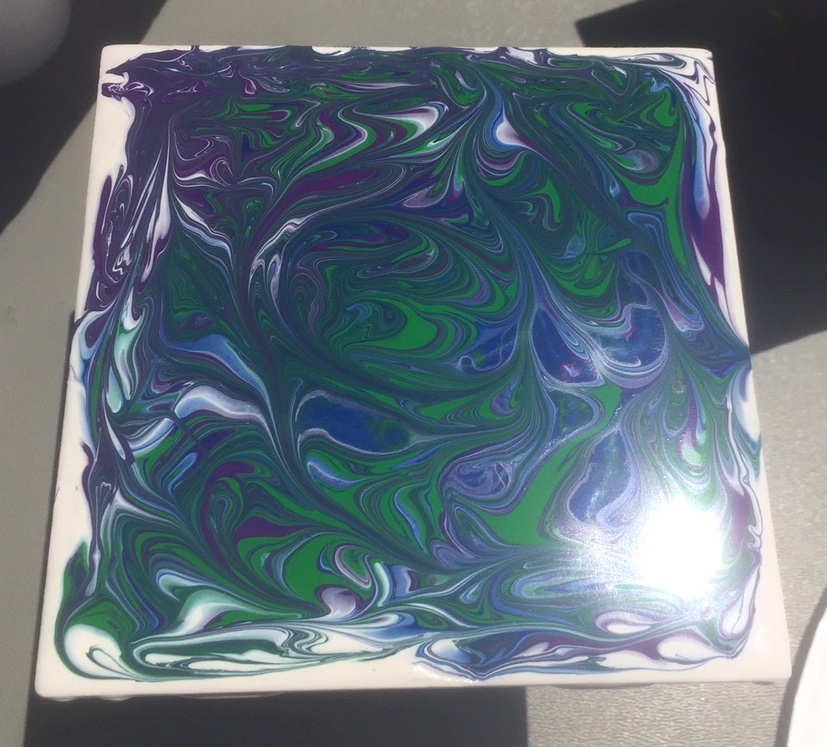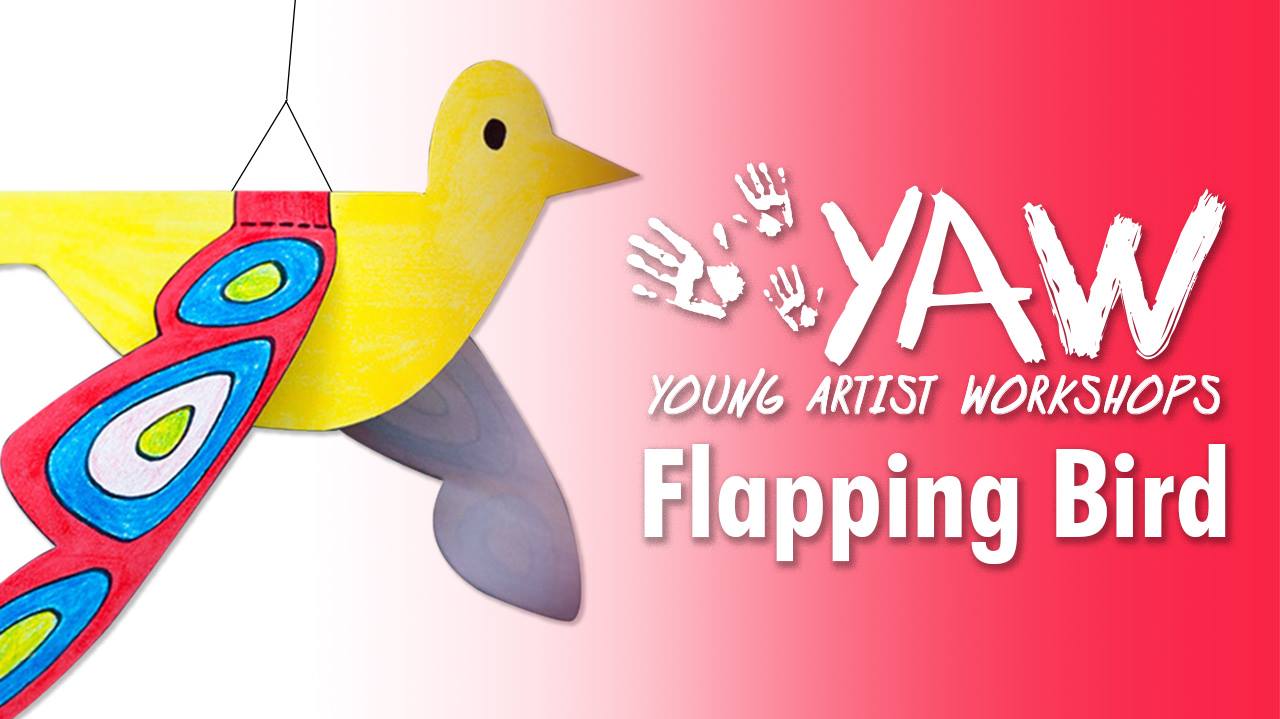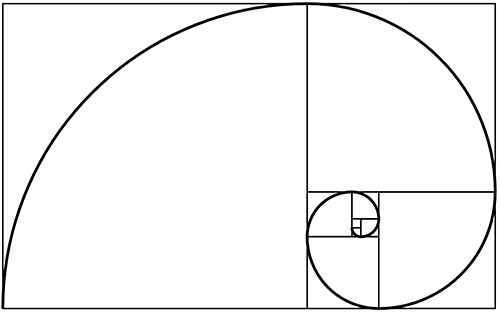Dani Dodge ended her 2019 residency at the Prime Desert Woodland Preserve by capturing the sunset.
Read MoreLast activation captured creativity and joy /
Sunday was the last activation of my 2019 artist residency at the Prime Desert Woodland Preserve. Despite the rain, a number of people came out to be captured by an instant camera against a desert backdrop. And then to create individualized frames for the photos.
Options for decorating the frames included many vintage materials I have been collecting for years for use in my artwork. It also included fun contemporary items such as tiny pompoms and pens for drawing, both on the frames and the photographs.
This time, as with all the other activations, I was inspired by the creativity that each of the participants displayed, and how each work of art was so unique to each individual. Some people made their artworks into a picture for the wall. Others made them into ornaments for the tree. But each child and adult went away with a smile.
This is been so much fun. Check out the pics!
Last activation this Sunday! Last month, we did watercolors. /
This month’s Art Activation on Sunday is the last of my yearlong residency at the Prime Desert Woodland Preserve. Here is an image of Catherine Ruane at last month’s activation with the watercolor she created!
Read MoreQ&A with Rob Grad /
Photography: Beyond the Surface:
Opening reception: 4-6 p.m. today, Saturday, Nov. 9, 2019
Exhibition runs: Nov. 9 - Jan. 12
Address: 665 W Lancaster Blvd, Lancaster, CA 93534
Solo exhibitions: Matthew Finley, Rob Grad, John Peralta, Melanie Pullen, Christopher Russell, Joni Sternbach, Rodrigo Valenzuela, and a site-specific installation by Kira Vollman. Selections from the Permanent Collection are also included in the exhibition.
Rob Grad is a musician and visual artist. He manipulates photographic images into sculptural objects. Rob is in the current show at MOAH, the Museum of Art and History, titled Photography: Beyond the Surface. The opening reception will be 4 to 6 p.m. today, Saturday, Nov. 9, 2019.
Q: Tell us about the work you have in the show at MOAH:
When I met with the curators at the museum to choose which work to include in the show, I had a new series started that I really thought would make the best exhibition. They liked the couple pieces I had, and we went with it. The only problem was that the series was in its infancy, and I had just committed myself to a big show without really having mapped out what I was making.
So it’s been an interesting journey making this work. I just dove in and let the images sort of tell me where to go with it.
I came up with a series is called “Finding Foreverland.” It was inspired by a poem I wrote about the wisdom and authenticity of a flower’s life. “The most delicate flower is still a badass…It even looks good old. And dies without apologizing.”
I decided to create metaphorical characters, essentially personifying nature into beings who are struggling to grasp the wisdom and natural ease of life that the flower so naturally embodies.
I used photographs I took in natural settings in different times and places, being most interested in the alchemy of complementary environments rather than any particular time and place. Then I cropped the photos into hand painted shapes with colors and text, and assembled them as 3D wall hangings. I knew I was throwing away the classic rectangular formate, but I don’t think I wound up with a single straight line or right angle in any of the works. I’m feeling pretty good about that.
It’s sort of a complicated process, but feels really natural to me now. This series also has my largest piece to date. It’s installed on a 25’ x 25’ wall as you walk into the museum. You can’t miss it when you walk in. It’s big. And loud. Working at that size presented a lot of new challenges to me that I really enjoyed figuring out.
Q: You are both a musician and visual artist. Do the two artistic mediums build on each other, or do they compete for your time?
My years in music absolutely influence my visual work. I bring a lot of elements together that normally might seem incongruous, and make them cohesive. Much like different instruments layered together compose a recording. The spontaneous way in which I make my shapes also have a performance element to the process.
I view all creative endeavors like speaking different languages. The art is in the communication of an idea and/or feeling. There are infinite mediums and different ways to do that. So when I started focusing on visual work about 10 years ago, it really just felt like I was learning a new language.
The two mediums don’t really compete for time anymore. Unless a specific project comes up, like a music video for TikTok China I did over the summer with a movie director, I devote 90% of my time to my visual work. I do have an EP I’d like to put out next year of a performance art bit I did in Paris and LA. I love those songs and it’s bugging me I haven’t put them out.
But otherwise, I’m grateful and fortunate to have as much work in my visual world as I do, so I’m focused on that.
Rob Grad, Spectator 3, based on visit to Prime Desert Woodlands Preserve
Q: You recently visited the Prime Desert Woodland Preserve in Lancaster. Tell us about your experience and how nature can inspire art.
I loved it there! A beautiful oasis. I grew up going to the desert for our family summer vacations. It was hot as hell, but cheap and quiet. I learned to really appreciate the stillness. My wife Ellie and I took a nice walk through the Preserve. Lots of raw material for artwork. Cactus have so much personality and can be fantastic metaphors. I use them a lot. Especially in this new series.
Nature IS art. Composition. Arrangement. Color. We as humans can never match that. All we can do is contribute. If you really analyze nature, I think you can learn 90% of what it takes to be an artist.
Q: How important is photography in your artistic work?
Photography is key for me. Most of my work represents a contrast in my internal and external worlds, and photography allows me direct reference to physicality. I don’t know if I’ll always use it this way, but for now, I see it as one of my main foundational building blocks. Having said that, I’ll almost never use a singular photograph. They are multiple exposure, or layered, or cropped into my painted shapes. There are a lot of people in this world who can take great pictures of things. That’s not my sweet spot. I use photography as a tool.
Q: What career highlights are you most proud of and why?
Pride. Interesting question. I have some good memories, but I’m not sure how proud I am :)
Musically, getting signed to RCA Records with my first band, Kik Tracee when I was 20 years old. It was a huge accomplishment that most musicians never get to experience. It was a great ride for awhile. I’d have to say the 20-minute performance I did on the Simone-de-Beauvoir bridge in Paris. I had a magical experience in Paris on vacation once, and to hear my music bouncing off the walls of the Seine years later, while the sun was going down, I teared up. Also, in my second band, Superfine, I didn’t wear pants for 4 years. Only pajamas. It started as fun thing, and then it became a “thing” of its own. I had a huge collection, and even had a pajama tour on the band’s website for awhile.
In my visual work, there are quite a few things. I think the fact that I’m here at all, doing this, even answering these questions, is something I feel good about. I've loved art my whole life. But for years when I was strictly a musician, I figured maybe I’d paint in another life. Or when I retired. I had no idea it’d be something I would wind up doing full time. I love it. I showed in Basel during Art Basel, and SCOPE in Miami. 2019 has been a transformative year for me in my visual work and I know I’m just at the I’m grateful for the experience I’m having with my work and been really trying to take some moments to honor that. It’s easy to just keep barreling ahead.
I’m also proud of the work I have at MOAH opening this weekend. I think this will be my best show to date. I pushed myself way beyond what I was comfortable doing and I think it paid off. I am also just finishing a 32’ commissioned mural in a building in Brentwood. It gets installed in a few weeks. It’s some of my best work.
Q&A with Christopher Russell /
Photography: Beyond the Surface:
Opening reception: 4-6 p.m. Saturday, (November 9, 2019)
Exhibition runs: Nov. 9 - Jan. 12
Address: 665 W Lancaster Blvd, Lancaster, CA 93534
Solo exhibitions: Matthew Finley, Rob Grad, John Peralta, Melanie Pullen, Christopher Russell, Joni Sternbach, Rodrigo Valenzuela, and a site-specific installation by Kira Vollman. Selections from the Permanent Collection are also included in the exhibition.
Christopher Russell is a writer and visual artist. He uses photographic images as a basis for mixed-media works and installations. He received his MFA from the Art Center College of Design, and has had a solo exhibition at the Hammer Museum.
Christopher is in the upcoming show at MOAH, the Museum of Art and History, titled Photography: Beyond the Surface. A former Los Angeles resident, Christopher now lives in Washington state.
Tell us about the work you have in the upcoming show at MOAH:
The work comes from time I spent living in Portland, Oregon, and ideas that I’ve been developing around the death of photography. Essentially, the predominance of digital images has shifted the societal understanding of what a photograph is, disrupting the foundational understanding of the photographic process: the perceived truth of its illusionistic image. Most of what is now produced and called photography comes from a process that privileges the malleability of images; it has a different foundational aim.
While photographing in the Columbia Gorge, I realized that I was operating on the opposite end of photography’s historical continuum. I was looking at more or less the same geography as Carleton Watkins, who photographed the same space in the 1860s, but our aims couldn’t have been more different. He was a documentarian who worked in partnership with the Oregon Steam Navigation Company, while I am unabashedly Romantic, and my move to Portland was a first step toward a more reclusive life. Watkins images were tack sharp, and his compositions helped define the popular conception of The West, while I throw fabric over the lens of my camera, and scratch into the resulting prints.
There was no record of Watkins’ daily life on the Columbia Gorge expedition, so I decided to write it: a travelogue written in the spirit of a photographic process that was designed for manipulation and consequently embraces fiction. The book in this exhibition is the first section of a larger text. It details the first leg of Watkins’ journey: the boat ride from San Francisco and his trip to Willamette Falls. The images in the exhibition are all waterfalls. Sometimes that is represented simply by a break in pattern, sometimes it’s an attempt to make the paper appear to cascade from its substrate.
Why did you take up photography as your main visual art medium?
I came to photography in the mid 1990s. I was drawn to the process, the ability to record reasonably accurate shapes and tones from the world around me. I was immediately taken by photography as a medium of surveillance. There have been lots of shifts in focus, like writing and bookmaking, but those other activities have always been informed by a conceptual relationship to photography.
You are both a writer and visual artist. Do the two artistic mediums build on each other, or do they compete for your time?
Yes. The two both build upon and compete with each other. My work exhibits primarily in a visual art context, so I think most people assume the writing is subordinate, or perhaps even superfluous—when it’s even noticed at all. For me, the tension between the two is productive. The work on the walls of the exhibition, the “waterfalls,” are a response to a challenge posed by the text. There is a lovelorn Watkins whose opinions become, sometimes, too clear. Then there is the object of his affection who is only known to the reader through Watkins descriptions. The third main character is Bigfoot, who exists primarily through forensics: footprints, hairs caught on a log, or a gift delivered while Watkins sleeps. Much like a photographic portrait, two of the main characters are established from a distance, their interiority is revealed through a relationship with somebody else. For me, the next set of questions is how one might create a similar dynamic of distance and presence within a visual work. So making the images became a process of trying to find material metaphors for “waterfall.”
How does nature inspire your art? Do you ever find inspiration in the desert landscape?
Nature is counter culture. Every aspect of society is set up to create a separation between man and nature. It’s why we can’t begin to to truly combat the climate crisis, nature, the actuality of nature—not the myriad symbols that evoke it—has been othered to the point that it holds virtually no cultural significance.
When you’re in nature, it’s perverse, scary, lonely. There is a place I visit near my home in Northeastern Washington State that is defined by lichen covered basaltic knolls within a field of yellowed grass that surrounds an ever-choppy, lead colored lake. In an instant this scene delivers all the drama of Wuthering Heights. It’s a type of beauty that is physically exhausting. It’s perhaps a better connection to the ideas of Kant or Friedrich than reading or viewing their work.
The desert is amazing, I remember these waddling miniature dinosaurs that shoot blood from their eyes from my time in Southern California. (Horned toads.) But I really can’t handle the heat, and that’s a major factor in my recent succession of northward moves.
What tips do you have for people photographing nature?
There is no other goal than the pursuit of radical reinvention.
Last month, masks. This Sunday, watercolor! /
For last month’s art activation, we made masks of desert animals that you might see in and around the Prime Desert Woodland Preserve: Jackrabbits, cottontails, mice, owls, coyotes, and bobcats. There were three tables set up. One for cutting out the masks using templates, one for painting the masks, and one for decorating them! (SO MUCH GLITTER!)
It was crazy fun.
This Sunday (11 a.m. to 1 p.m. Nov. 10, 2019) we will paint watercolor images of the desert. All supplies are included. All ages are welcome. But before we get started on that, let’s look at the fun we had in October!
Art activation Sunday ... mask making! /
From 11 a.m. to 1 p.m. Sunday (October 13, 2019) we will be making masks at the Prime Desert Woodland Preserve that are inspired by the animals within the preserve!
Last month, we used watercolor crayons to draw and paint gorgeous art works inspired by the desert. I was super impressed by the colorful creativity participants showed! With mask making this month, we will take that creativity to the next level by thinking of the “shape” of our canvas, too. I’ll bring the glitter, paint, and mask-making supplies. You just bring you. What animal will you pick?
Here’s some images from last month’s art activation!
Q&A with artist Erika Lizee /
Erika Lizée with her work, Infinite Love/Flesh and Blood, at the Lancaster Museum of Art and History.
Erika Lizée has created a site-specific installation at the Lancaster Museum of Art and History, a short distance from the Prime Desert Woodland Preserve. Her work mirrors the beauty and symmetry I find at the Preserve, so I wanted to talk to her about the ideas behind her art.
Titled Infinite Love/Flesh and Blood, the sculptural acrylic painting spans three floors in the MOAH front entrance and seems to jump off the wall as if to embrace the viewer. It creates a magically biomorphic vision, which is at the same time strange yet familiar.
The stunning work is currently on view at MOAH as part of L.A. Painting through Oct. 20, 2019. The exhibition also includes Five Year Survey curated by Cooper Johnson, a solo show by David Allan Peters, Laura Hipke and painter Shane Guffogg’s curatorial project Circle of Truth, a solo show by Kaye Freeman in collaboration with Amy Kaps called The Anatomy of a Painting, and selections from the museum’s permanent collection.
So, I asked Erika:
Q: How does your art in the current show at MOAH relate to nature?
A: Three years ago, I began studying the numbers one through 10 as well as sacred geometry with the aim of exploring the interconnectedness of the world we live in through numbers and shapes. My installation for MOAH is inspired by the number 8 and visually references the clematis flower, oxygen (the eighth element on the periodic table), the eight notes in an octave, and the symbol of the infinite.
Q: What do you find interesting about nature as an artist?
A: I spent my childhood in the woods and lakes of Northern Wisconsin, so I have always felt a strong connection to nature. Artistically, nature is an infinite source of inspiration. I am drawn to the complex range of beautiful forms, colors and textures.
Q: Is there a place you go to enjoy nature?
A: I live in the canyons northwest of Los Angeles with my husband and two kids. Typically we go hiking in the hills up behind our house. It is so wonderful to be able to walk out our front door and explore the rocks and trails (and admire the views!) in our community.
Q: What is your artistic background?
A: I have a BFA in Painting from the University of North Carolina at Asheville, and an MFA in Painting from CSU Northridge. Over the past 20 years, my artwork has transitioned from oil paintings, to graphite drawings, to acrylic paintings and now large-scale illusion-based installations.
Q: What is next for you?
A: 2019 was a very busy year for me. In March, I installed my first permanent installation inside the YMCA in Westlake Village, and then in August, I installed this large-scale installation inside MOAH. Right now, I'm taking a breath; spending time researching and working on design ideas for the next project. I am the Visual Arts Department Chair and Art Gallery Director at Moorpark College, and have been teaching a Watercolor class this fall for the first time, which has been great fun.
When you aren't around ... bunnies kiss! (Part 3) /
Ever wonder what happens when you aren’t around at the Prime Desert Woodlands Preserve. What do the animals do? Well, I wanted to find out. And, boy, was I shocked. Did you know jackrabbits “kissed” and “played”? Just watch these videos!
This is the third in a three-part series, each catching a different vantage point in the Preserve with a motion sensor camera. This camera was placed just outside the large window of the visitor’s center, pointing out into the Preserve. Of the three cameras we set out, this one captured the most interaction between wildlife, and the most fun animal action. Did you know that jackrabbits played and kissed while you weren’t around? Well, I had no idea.
Thank you to Museum of Art and History Curator Robert Benitez and MOAH staff. These videos would not have been possible without your guidance and assistance.
When you aren't around ... Part 2 /
Ever wonder what happens when you aren’t around at the Prime Desert Woodlands Preserve. What do the animals do? Well, I wanted to find out.
This is video from the second of three motion sensor cameras set out in the preserve this summer. This one was attached to a post under a bridge and pointing into a clearing. Of the three cameras, this one captured the biggest variety of animals … even a coyote and a very strange mystery animal. Do you know what it is?
Thank you to Museum of Art and History Curator Robert Benitez and MOAH staff. These videos would not have been possible without your guidance and assistance.
When you aren't around … (Part 1) /
Ever wonder what happens when you aren’t around at the Prime Desert Woodlands Preserve. What do the animals do? Well, I wanted to find out. With the help of Museum of Art and History Curator Robert Benitez and MOAH staff, motion sensing cameras were set up at three locations within the preserve. Over the next week, I’ll give you a peek what was captured from each location!
This first camera was attached to a tree and pointing into a clearing in mid-July. Unlike the other two cameras that captured thousands of 5- and 10-second videos and still images, this one collected only a few hundred. But, unlike the others, it was close enough to capture sunlight coming through the thin skin of the jackrabbit’s tall ears.
Enjoy.
Telling desert stories with cyanotype /
Last month’s activation brought out desert explorers who created rich images using an ancient photographic process called cyanotype. At Sunday’s activation, we will use watercolor crayons to paint vivid pictures!
Please join us from 11 a.m. to 1 p.m. Sunday, Sept 8, 2019 at the Elyze Clifford Interpretive Center!
In the meantime, let me tell you about the fun we had last month.
First, participants gathered materials from the desert floor or the Interpretive Center. Those items were placed onto photographic paper and put into the sun. After about 14 minutes, the items were removed and the paper was rinsed and left to dry.
Afterwards, we had incredible photographic memories of the day!
I look forward to seeing you all Sunday.
Poetry expanded on desert's beauty. Next Sunday? Cyanotype! /
Our next activation at the Prime Desert Woodland Preserve is from 11 a.m. to 1 p.m. on Sunday, Aug. 11, 2019. We will make cyanotype images of desert rocks and plants! It’s a process rooted in photographic history that allows people to essentially take a photo without a camera. Please join us! All ages welcome. All materials will be provided. RSVP here.
Last month, participants in our art activation waxed poetic about the desert and its beauty. Participants first spent some time in the desert and recorded words that came to them. They returned to the visitor’s center with notebooks full of ideas and images and turned those into beautiful Haiku poems. Here’s a few examples of the beautiful poems and images they created.
Joshua trees
Baby Joshua
tree makes me happy because
it’s growing like me.
Ants
Feel like they will crawl
on me. They carry their dead
finding food. Hard workers.
-Anthony, 7
Tumbleweeds
Tumbleweeds. Loners.
Brittle beings in the sun
Quiet. Watching, still.
-Andrea
Squirrels under a
blueberry tree just feasting
fearless watching me.
-Nathan
The Rocks
Some are large and small
All different colors and shapes
They are just like us.
-Hunter
Raven’s craw pierces
The desert’s silent witness
And cuts through the heat
-Viv
Q&A with Snezana Saraswati Petrovic /
Collateral Damage
By Snezana Saraswati Petrovic
at MOAH:CEDAR
July 6 - August 18, 2019
Artist talk from 4-6 p.m. August 17.
44857 Cedar Ave, Lancaster, California 93534
Hours: 2 to 8 p.m. Thursday to Sunday
Snezana Saraswati Petrovic’s current show, “Collateral Damage” is on view at MOAH:CEDAR through August 18. The immersive installation speaks of the harm humans do to nature unintentionally. In this Q&A Snezana shares her connection to nature, her first impressions of the Prime Desert Woodland Preserve, and why art matters.
Q: Snezana, when did you first become interested in looking at nature from the perspective of an artist?
A: This is hard question. I believe that we are the nature. We might be separated superficially by the urban boundaries, but we all experience the day/night rhythms and respond to changes in weather. The most of art production is happening in the cities. The disconnection with the nature is resulting in the need to create arts. While in art school I learned about Andrew Goldsworthy works, his “collaboration with nature” and Earthworks art. I came to realization that I was doing the same since my childhood.
Snezana Saraswati Petrovic within her exhibition Collateral Damage
I was occasionally spending summer at my grandparent’s property that was secluded and not accessible by the cars. I would go into the forest where the path would take you down to the roads collecting on the way the leaves, twigs, corn “hair,” grass, rocks and wild snail shells. On the pathway to where my parents would eventually climb up on the weekends to see me, I was making dolls, “things” with unknown and mystical purpose while placing them inside of marked spaces that now, I see it as some form of shrines.
I always felt to be a part or one with the nature and not separate from it. Artist are in some ways echoing an image of a Creator, while creating instead of imitating. This was a common stance in Renaissance. Titian painting “St. Sebastian” was described as “the hand that emulates the hand of the Creator” or “la mano imitratice de la man creatrice”. Life, nature, creation are all one. Artist is just a vessel. I think I knew this since my childhood days sitting in the forest and creating by the rhythm of the spring water and winds.
Q: Have you always been drawn to nature?
Snezana Saraswati Petrovic, Collateral Damage
A: Yes, and in unexpected ways. I grew up in an urban environment surrounded by bricks and concrete with occasional trees and parks. My US friends refer to Belgrade, the city of my youth, as “low budget New York” with over one million population. In this high concentration of people, cars, and buildings, magic happened every early spring when the trees blossomed. The white petals and light green leaf cheered up the gray streets and in early summer this all turns into the saturated scent of linden trees blossoms and deep green shadows.
I wanted to experience more of this verve and tingling energy and as a child I asked to spend summers at my grandparent’s property that was not in use for decades.
Beside my walks through the forests while hearing inner music and stories, I was talking to the trees, spring water, and winds. I would spend half of a day laying on the top of the walnut tree learning how to be a branch and moving with the wind.
This experience is something that I was trying to evoke in my recent installation at MOAH Cedar with a focus on the oceans, balancing the dry desert hot weather with coolness of the blues and serenity that water brings.
Q: You recently visited the Prime Desert Woodland Preserve. What were your thoughts?
Snezana Saraswati Petrovic, Collateral Damage
A: I was visiting on the early morning the preserve, before installing my work at MOAH. It is place of contemplation and beauty. The morning breeze, the bright but not hot sun, intensified the green and vigor of Joshua trees. I was hiking happy, knowing that bikes, noise, any wheels are banned from this space. Similarly to this preserve, the idea of having community-based conservancy is of the essence in my current piece ”Collateral Damage” at MOAH Cedar. The Prime Desert Woodland Preserve exemplifies the idea of grass-root community care for the nature. It also shows that determination, care and respect for our habitat can rejuvenate and flourish.
By having more examples like this perhaps, there is hope for the Earth?
Q: Do you feel that you saw the Preserve differently through the eyes of an artist? How?
Snezana Saraswati Petrovic, Collateral Damage
A: We all have ability to connect to nature as we are nature. An artist way of seeing it is perhaps, ”larger then life”? The experience of walking down the Preserve’s path of sand and small rocks, while listening to your own footsteps, hearing birds and buzz of life can inspire an artist to create. I can imagine that feeling of rejuvenation and cleansing might be shared experience with everyone else.
I contemplated for a long time Pablo Picasso’s statement that “Through art we express our conception of what nature is not.” I could not find any evidence in my practice for it. Artists do have unique perspectives individually, even from each other, but we are the creators. Nature is of the same essence. Creating in disconnect from the nature may be the reason for Picasso’s statement? Hegel was of the opinion that art “cannot stand in competition with nature…and if it tries it looks like a worm trying to crawl after an elephant.”
My position is the middle ground.
My morning inner dialogues in Prime Desert Woodland Preserve reassured me that my choice of topic in my MOAH CEDAR exhibition is of relevance to the current moment and all of us.
Snezana Saraswati Petrovic, Collateral Damage
Q: Why does art matter?
A: In this time and age, globally and nationally, art might be the only voice of serenity and wisdom.
Art heals, encourages us to be better humans, proposes questions and helps us find the answers. Art is necessity of humanity since the dawn of civilization. The return of tattoos and graffiti art shows the need to visually communicate and express our existence, even without art training or knowledge of art history.
I agree with statement by John F. Kennedy: "We must never forget that art is not a form of propaganda; it is a form of truth."
Q: Your exhibition at MOAH:CEDAR is stunning. Do you know what your next project will be?
A: I will have to continue with different incarnations of this project and in multiple locations. The dedication of saving and preserving our habitat and humanity is life-long project. After my yogic studies in India and upon receiving my spiritual name Saraswati (Indian goddess of knowledge and art), I was not very clear on my goals. The “Collateral Damage” installation clarified the direction to me as an artist that brings the knowledge of science and art to the benefit of all.
Q: What is your artistic background?
A: I have BFA degree in painting and scenography from University of Belgrade, Yugoslavia. The five years program embodied the Renaissance artistic training where the artist emulates the nature and works of Master of Art, while discovering unique perspective in the process of growth. I was trained to replicate any style of drawing or painting from Durrer to Van Gogh to Picasso.
My first job in LA was making the exact replicas of Van Gogh such as “Night Café,” “Starry Night” and Picasso’s “Portrait of a Harlequin,” for the galleries abroad represented by Platinum American Express
My MFA is from the University of California, Irvine with double emphasis in video/digital arts and theater design. I continue to wear multiple hats as studio artist, designer and emerita art professor.
My video/installation practice is inspiring my theater design practice and vice versa. I am recipient of numerous awards both in US and Europe, such as “Golden Arena” for Production Design in feature movie “Harms Case” or “Ovation 2010, Los Angeles” for the costume design in Large Theatre category. I was awarded UC Regents Grant and National Endowment for the Arts.
I have exhibited my work nationally and internationally in Amsterdam, Singapore, Tokyo, Prague, Los Angeles and Belgrade, at the venues such as Los Angeles MOCA and Stedijilk Museum, Amsterdam.
Last month was painterly. Sunday will be poetic. /
After an incredibly fun activation last month, we are super excited about Sunday! From 11 a.m. to 1 p.m., Sunday, July 14, 2019, we will have an art activation at the Prime Desert Woodland Preserve in Lancaster, Calif.
During the activation, participants will create illustrated Haiku, that they can take home to frame or just put on the fridge. All ages are invited. All supplies will be provided.
But, before I go on and on, check out these photos from last month’s activation. Participants captured the desert with water-soluble crayons and pencils, and then used water to turn them into watercolor masterpieces. The art was amazing!
Pokémon in the Preserve /
Rebecca Warner playing Pokémon at the Prime Desert Woodland Preserve
Read MoreMother's Day Art Activation: Love and beauty /
At the last art activation on Mother’s Day at the Prime Desert Woodland Preserve, dozens of people made colorful tiles. The next art activation is this Sunday (June 9, 2019) from 11 a.m. to 1 p.m. Participants will make watercolors from crayon drawings!
But more about last month. Boy, did we have fun! And here’s one other thing: Two of the tiles made then will be part of an art display at the visitor’s center next year! And here’s the other cool thing: One or two pieces from each activation will be part of that show!
March in Lancaster: Moon Walks, blue antelope and temptations /
Often people have the image of Lancaster as a sleepy little town where there’s nothing fun to do.
They could not be more wrong.
There are many exciting art and education-related events, presentations, activities at the Museum of Art and History and the Prime Desert Woodland Preserve every month. March is no exception.
Here is just a sampling of some of the fun:
Saturday, March 16
1 p.m.
Dinosaur Presentation
Prime Desert Woodland Preserve, 43201 35th Street West, Lancaster
Dinosaur expert Richard Wade offers an interactive demonstration on the “Last Days of the Dinosaurs” including a full-scale model of a T-Rex skull.
$3, ages 3 and under free
Details on Preserve website.
1-2 p.m.
Peace on Earth: Artist Panel Discussion
Lancaster Museum of Art and History (MOAH) 665 W Lancaster Blvd, Lancaster
Hear from a few of the artists in the Peace on Earth exhibit at MOAH in this panel discussion led by museum curator Andi Campognone. Artists include Cynthia Minet, James Griffith, Catherine Coan and Luke Matjas.
Free
Details on Facebook.
1-4 p.m.
Art in Residence
THEN | NOW | A | DREAM
Location: Antelope Acres, CA at the foot of the Antelope Valley Poppy Reserve. 34°43’39.0″N 118°22’12.7″W
Artists Nathaniel Ancheta and David Edward Martin have created an installation that includes four life size sculptures of a pronghorn antelope, made of rebar, found/discarded material and painted super saturated blue.
NOTE: There also will be a meet- and-greet for Art In Residence at MOAH: CEDAR from 5-8 p.m. Supplemental work on related to the current installation will be on display.
Free
Details on Facebook.
3-6 p.m.
Temptations in Fairyland: Performance by Jason Jenn
MOAH: CEDAR, 44857 Cedar Ave, Lancaster
The visually delightful artworks installed in Leonard Greco Jr.’s “Fairyland” at MOAH: CEDAR are both the basis and setting for the live performances of “Temptations in Fairyland” by multimedia performance artist Jason Jenn at 3 and 5 p.m.
Free
Details on Facebook
6-10 p.m.
MOAH: CEDAR Board Game Café
Cedar Center for the Arts Memorial Hall, 44851 Cedar Avenue, Lancaster
Gamerunner Amy Bruhl will curate a selection of tabletop games from her extensive collection of the latest independent board games as well as a few favorites.
Attendees must RSVP to 661-723-6250.
Free
Details on Facebook
March 21 (Thursday)
3-7 p.m.
Young Artist Workshop: Flapping Bird
Lancaster Museum of Art and History (MOAH) 665 W Lancaster Blvd, Lancaster
Stop by between 3 and 7 p.m, for the Young Artist Workshop, where young artists will make their own Flapping Bird. All materials will be provided by MOAH.
More about young artist workshops: https://www.lancastermoah.org/young-artist-workshops
Free
Details on Facebook
March 23 (Saturday)
8-10 a.m.
Special Needs Community Day
Prime Desert Woodland Preserve, 43201 35th Street West, Lancaster
Park Rangers, in partnership with AV Seed and Grow/AV Cultivar y Crecer and Quality Behavior Solutions, provide walking tours and early access to the Interpretive Center.
Free
Details on Preserve website.
7 p.m.
MOAH: CEDAR Concert Series
MOAH: CEDAR, 44857 Cedar Ave, Lancaster
The concert series that will be held at Cedar Hall. On the lineup is Phovea, Valley Echo, Others, Cozzmos and Cruel Reflections
Free
Details on Facebook
7:30 p.m.
Moon Walk
Prime Desert Woodland Preserve
43201 35th Street West, Lancaster
Jeremy Amarant, Director of the Palmdale School District’s SAGE Planetarium leads a one-mile guided tour of the Preserve to discuss the night sky.
$2 donation welcome
Details on Preserve website.
March 24 (Sunday)
4:45 to 7 p.m.
Live Figure Drawing with Artist Leonard Greco
MOAH: CEDAR, 44857 Cedar Ave, Lancaster
This live figure drawing session will feature MOAH:CEDAR artist in residence Leonard Greco. Seating is limited so be sure to arrive early.
Free
Details on Facebook
March 30 (Saturday)
2 p.m.
Leonard Greco: Artist Talk
MOAH: CEDAR, 44857 Cedar Ave, Lancaster
Artist in residency Leonard Greco will talk about his current exhibition at MOAH:CEDAR, “Fairyland,” which touches on the weighty tableau of the Temptation of St. Anthony of the Desert and the perilous trials of Herakles.
Free
Details on Facebook
Learn more about other events this months, and in moths to come, at https://www.lancastermoah.org/ or https://www.cityoflancasterca.org/about-us/departments-services/parks-recreation-arts/parks/prime-desert-woodland-preserve
Art Activations begin at the Preserve on Sunday! /
This Sunday. Art activations begin in the Prime Desert Woodland Preserve!
These are special times—11 a.m. to 1 p.m. the second Sunday of each month in 2019—to come out to the preserve and honor it with your art, or by thinking about the desert in a more artful way.
The activations begin this Sunday with an opportunity to see nature in a different way by making a golden ratio finder. The golden ratio, or Fibonacci sequence, is an ancient way of finding the beauty of nature and art. We will create the golden ratio finders, and then look around the desert to find where it applies!
Fibonacci spiral, also known as the golden ratio
One of my favorite ways to explain the golden ratio is to let Donald Duck do it in this 1959 cartoon “Donald in Mathmagic Land.” Want more? Check out “Fibonacci Sequence Documentary - Golden Section Explained.”
So come out and make a golden section finder with me, and put the every second Sunday of the month on your calendar! All supplies are provided. All ages and experience levels are welcome.
Here’s what we have in store for 2019:
March 10 – Make a Golden Section finder.
See the desert like an artist. Make a golden section finder, and find how nature creates perfect proportions in the desert, and take then it home with you to find perfect proportions everywhere!
April 14 – Make a photograph without a camera.
Since the mid-1800s, naturalists have used the photographic process of cyanotype to record plants they found throughout the world. Now artists use it to make beautiful images. Make your own cyanotype using items found on the desert floor and take home a beautiful image of the desert.
May 12 – Paint a tile inspired by the desert floor.
Make a tile for you or your mom. Using the desert floor as our inspiration, we will create beautiful abstract tiles. These are perfect as Mother’s Day gifts!
June 9 – Painting the desert in watercolor washes.
We will experiment with wet-on-wet watercolor techniques to depict the dry desert.
July 14 - Finding words and images.
What comes first, the idea or the image? In this art activation, participants will first write a haiku about the desert on lovely watercolor paper, and then illustrate it with markers!
August 11 – Make a rain stick.
It’s been a very, very long time since we’ve had rain. Doesn’t mean we’ve forgotten the sound of it. Come out to the Prime Desert Woodland and make your own rain stick!
September 8 – Paint a desert scene with crayons. Watercolor crayons!
Draw a picture of the desert with crayons, and then use a paintbrush and water to turn it into a watercolor masterpiece!
October 13 – Making masks inspired by desert animals.
Go to Halloween as your favorite desert animal. Will you be a jackrabbit, raven, or a bobcat?
November 10 – Drawing desert bugs.
Sometimes it seems as if there is nothing alive in the desert. But that’s just not so. We will look for bugs, then examine them with magnifying glasses, and then draw them.
December 8 – Perfecting Polaroids.
Come to the Prime Desert Woodlands and have your picture taken with the desert as your backdrop. And then, use our paint and unusual framing supplies to make that image into a personal piece of art!
See you Sunday!
Nuri Amanatullah: Drawing us into the interactions with wildlife /
When you wander into the Elyze Clifford Interpretive Center at the Prime Desert Woodland Preserve, you will see something new, vibrant and captivating on the walls: the art work of Nuri Amanatullah.
The prints are inspired by random, chance interactions the artist has had with wildlife in and around the Antelope Valley.
Nuri Amanatullah
Photo: Sam Allen
“I once saw a roadrunner in a Del Taco parking lot and it affected me profoundly,” Amanatullah said. “It was the first time I had seen a roadrunner in person and I was surprised how large it was. It was beautiful, almost regal. And then I thought, 'what is this regal bird doing scrounging for scraps at Del Taco?’ “
He has seen a grey fox digging through a trashcan at nearby Devil's Punchbowl, coyotes sulking down his street in Quartz Hill like stray dogs looking for food.
“Then I started thinking about these unique encounters and how the Antelope Valley is one of those special places where the desert wildlife persists in spite of our disrupting presence. I wanted to portray the flora and fauna of the Antelope Valley, bold and vibrant, but not isolated,” he explained. “Often with natural photography and other forms of artwork there is a concentrated effort to separate the traces of humans, to deliver this false notion of pristine, unmolested landscapes and wildlife. I wanted to do the opposite and show the intersections where humans and animals meet.”
Art by Nuri Amanatullah
Amanatullah has been drawing since an early age. He received a bachelor’s degree in art from University of California, Santa Cruz. He moved to the Antelope Valley in 2008 because his wife was from here. In addition to being an artist, he is the art director for the Housing Corporation of America, a nonprofit organization that provides enrichment programs including art, fitness, and scholarship to affordable-income housing across Southern California.
Since moving to the Antelope Valley, his art has focused on the animal and plant life of the desert area. He has become enamored with the Prime Desert Woodland Preserve, which he considers one of the best places to experience the beauty of the natural world.
Art by Nuri Amanatullah
He said that he hopes that people who see his work at the interpretive center will walk away with a sense of curiosity and an eagerness to learn more.
“I hope that it's the same feeling I got when I was a child looking at animal specimens and dinosaur bones at the natural history museum,” Amanatullah said. “I'd like to restore awe in nature since it's so close to us now. At any given time of day you can spot a hawk sitting on a telephone pole off of Sierra Highway. Or ravens on top of buildings. Or coyotes scampering across vacant lots.”
He noted that humans have encroached on these animals’ environments, and they’ve learned to adapt.
“We're neighbors whether we like it or not,” he said. “So I'd prefer that the relationship between the residents of the Antelope Valley, especially the youth, and the creatures here is one of respect and wonder.”
To see more of Amanatullah’s work, check out his Instagram account or website.
Or, even better, stop by the Prime Desert Woodland Preserve to enjoy it in person, and then, go out on the trails to experience some of that natural beauty yourself.
Art by Nuri Amanatullah
